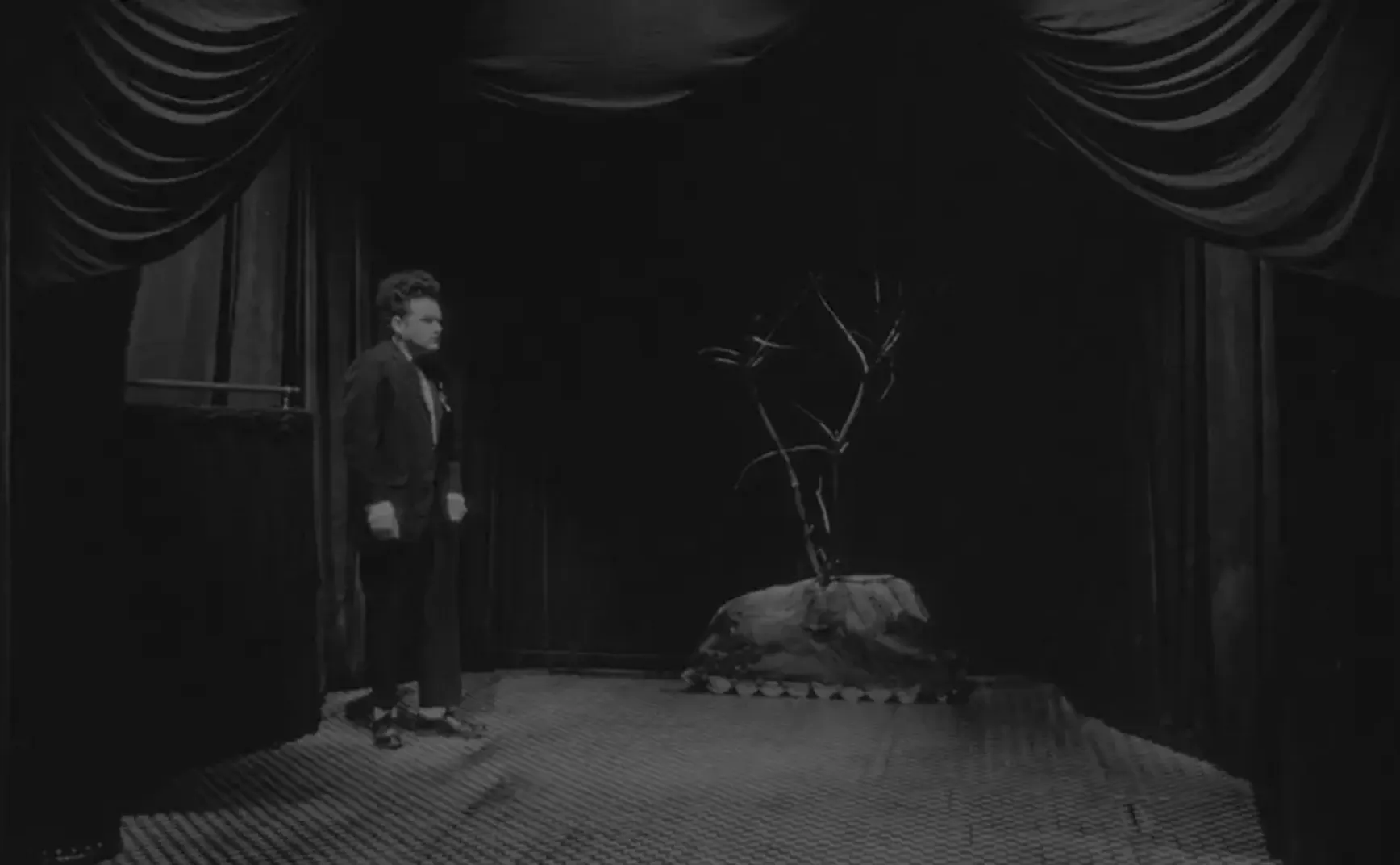Eraserhead is my most spiritual movie. No one understands when I say that, but it is.” (David Lynch, Catching the Big Fish: Meditation, Consciousness, and Creativity, 2006)
Popular opinion still regards Eraserhead in opposition to such spiritual motifs and in fact deems it as mostly dark and monstrous. My analysis of Eraserhead isn’t a typical one on parenthood, the familial or the human condition. Nor is it a broad stroke of the societal milieu and class critique of the time; propelled into meaning by critics and audiences alike - yet does not do it justice.
Rather, the focus and aim are to reflect on the film through the lens of analytical psychology (C. G. Jung) and naturally of its creator (David Lynch) by extension. On a grand scale, it is the meta film that broke cinematic ground; through ambitious abstraction, innovative storytelling and mysterious dream language. However, I believe it also parallels the unfolding of Lynch's own spiritual and inner development, demonstrating why his magic, reputation and creativity remain elusive, and a pinnacle of true artistry beyond film. Eraserhead marks the inception of David Lynch’s creative calling via an initiatory rite within the unconscious - reserved for the few and clearly the path less trodden. In respect to this, Lynch was able to leave a truly unique and incredible mark on the world.
I, like everyone else, watched Eraserhead with some befuddlement, wherein reality left us for an intense barrage of imagery beyond comprehension in the final act. Fast forward years on, and through my self-reflection and aim at transformation; I am synchronistically led back to this movie, and then gripped in the process. Here is a profound story of a deep dive into transformation, but not in the typical hero’s journey we see ad infinitum. This, I wager, is a rare representation of the inner journey that is just as dramatic and perilous. One that almost fails, but with a twist of events, is shown to birth anew and manages a holy marriage through the ghastly, unthinkable act of killing the defenceless infant-like entity; an enclosed part of the psyche is opened, which allows access to the feminine counterpart within – as it is no longer projected. The face value shock of the infant killing even if alien, permeates into many a review and analyses decades later. This usually leads to an interpretation of mental illness, fatherhood anxiety and/or evil from The Man in the Planet and Lady in the Radiator as though they are puppet masters from within or beyond.
I am offering an interpretation that demystifies some themes that are shown to overlap with depth psychology or alchemy, and aim to show the wrestling of the deeply personal and vital process of inner work, spirituality and the development of relationship through and to the unconscious. The opening of the film is a point about the perils of autopilot living that plagues society; it is of vital importance to be active agents in our own lives. While this theme is touched upon a few times as a reminder of its undesirable mode of being; the narrative of Eraserhead, through extreme strife, has a positive and fruitful ending - with conscious action leading the charge.
Source of alien creation, a forceful germination
The beginning of the film shows our protagonist, Henry, floating somewhere akin to a night sky, juxtaposed with what looks to be a moon rock, or a cosmic egg, if you will. He is depicted as open-eyed, but only partially aware, as if in a dream state.
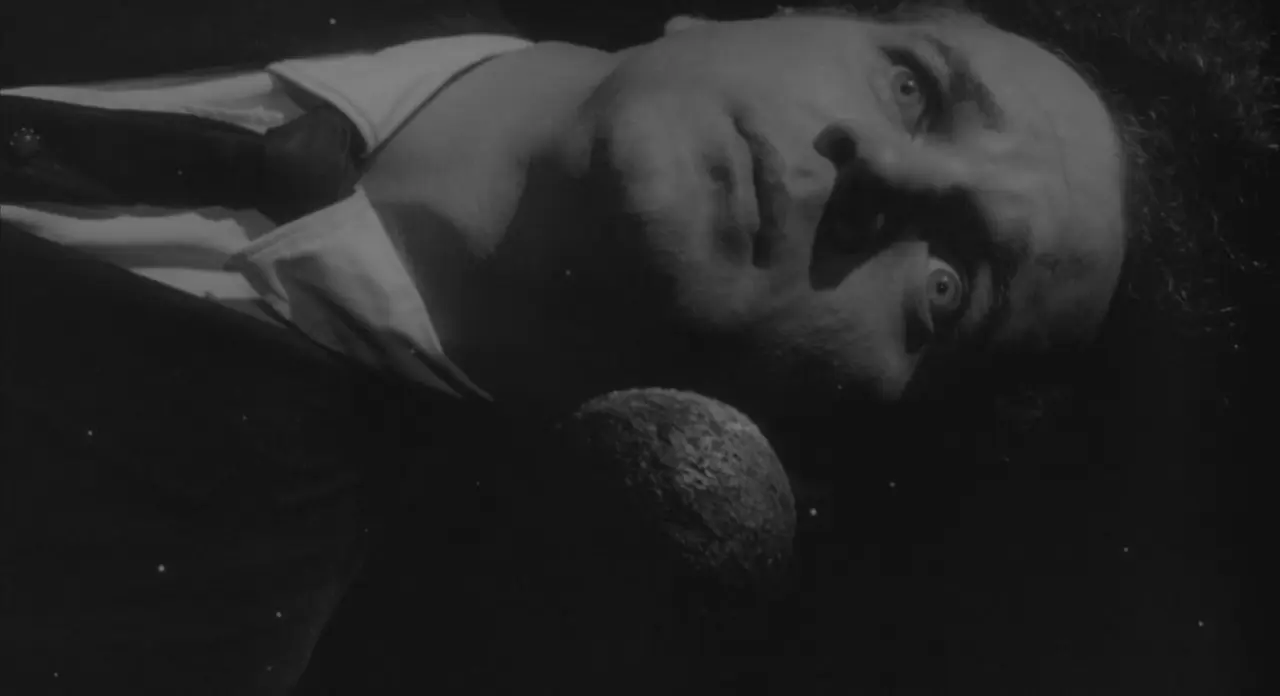
So while Henry is representative of ego-consciousness, the cosmos realm is indicative of the unconscious. The superposition of Henry and the moon rock is a significant symbol indicating the ego and the depth of self within the psyche.
Seen in this manner, the Man in the Planet revealed in the following scene is like a moon god. Inside his makeshift home, we get the sense he has been waiting patiently for an emergence of significant value, as he watches from his broken window. A play on the idea of the window to the soul or Man in the Moon.
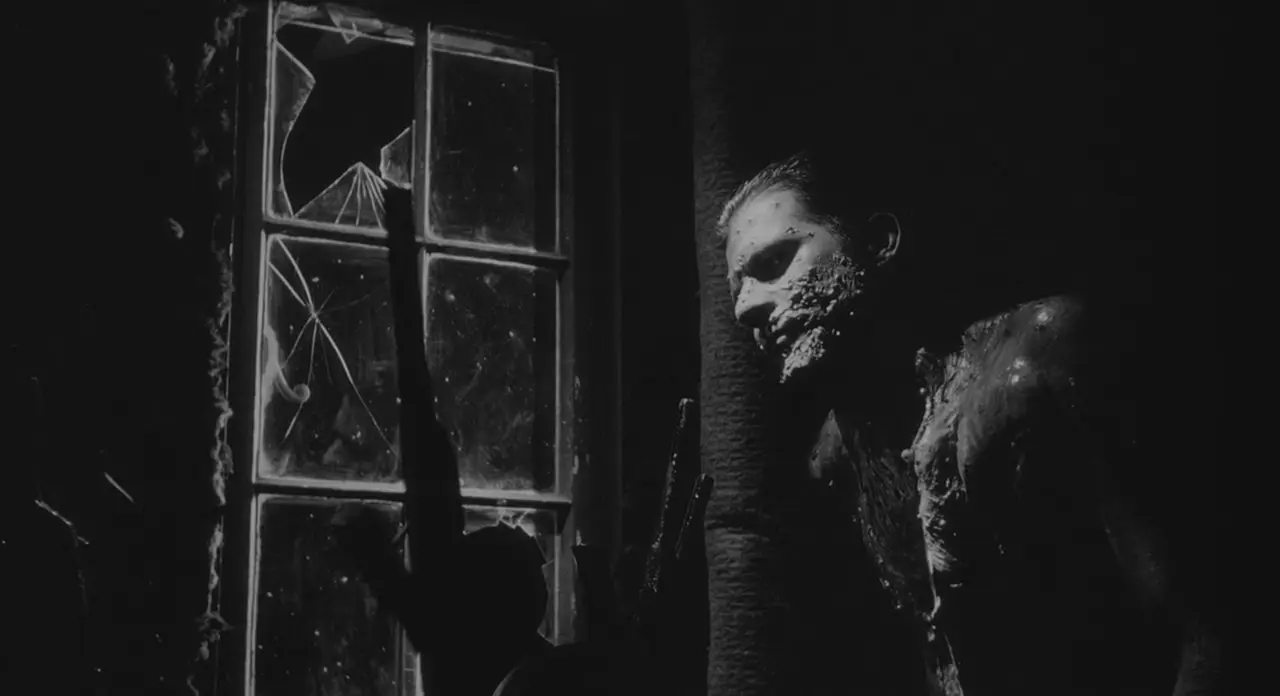
Henry births from his mouth, a life form that is sperm-like, which is symbolic of the generative principle of the masculine.
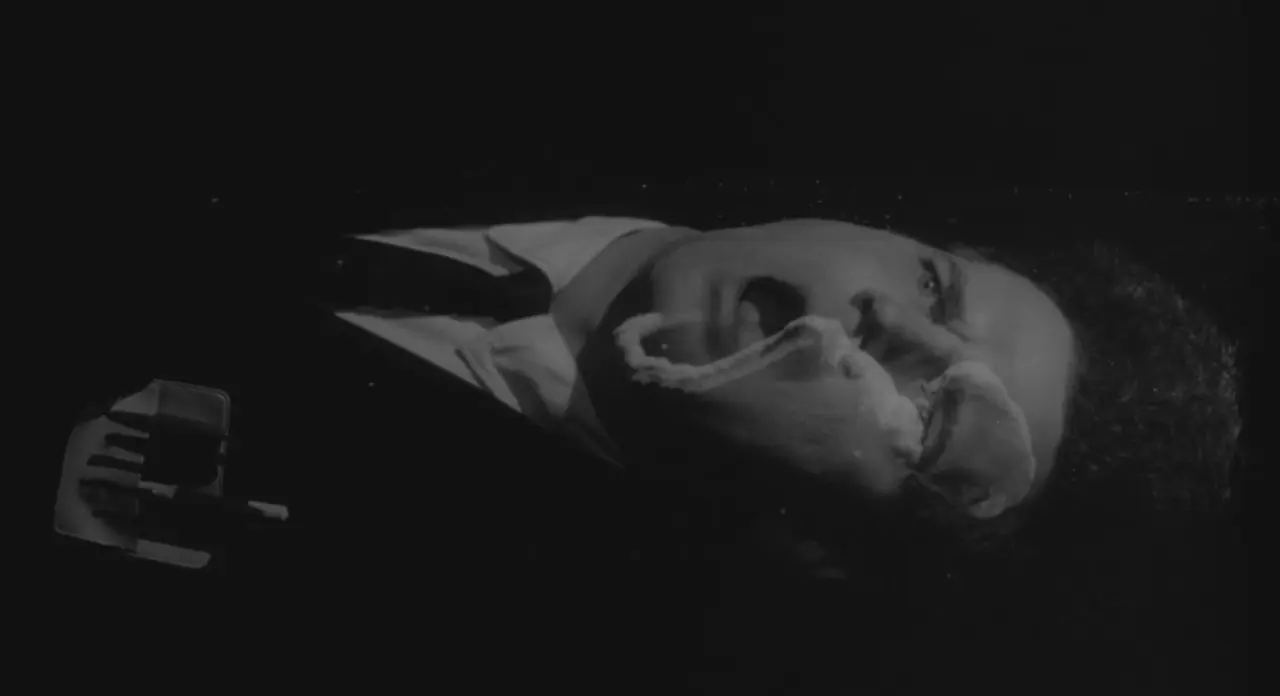
Suddenly, Man in the Planet is jolted into action and, with slight contemplation, carefully operates three levers and sends the sperm-entity from the depths of the unconscious into the conscious world, ethereal dust fills the screen.
“...the timing for the crucial transformation is chosen by the Self and not by the ego, even though it can be very helpful for the ego to have prepared itself for it so that it doesn't come as a complete surprise.” (Edward Edinger, The Mysterium Lectures, p. 210)
A choice was made deep within Henry, by the self, to let this generative principle go through the transformative process and have life. To stress a point, this is due to a dire absence of any other positive or substantive principles. It’s a last-ditch effort to kick-start personal development for the ego, from the self.
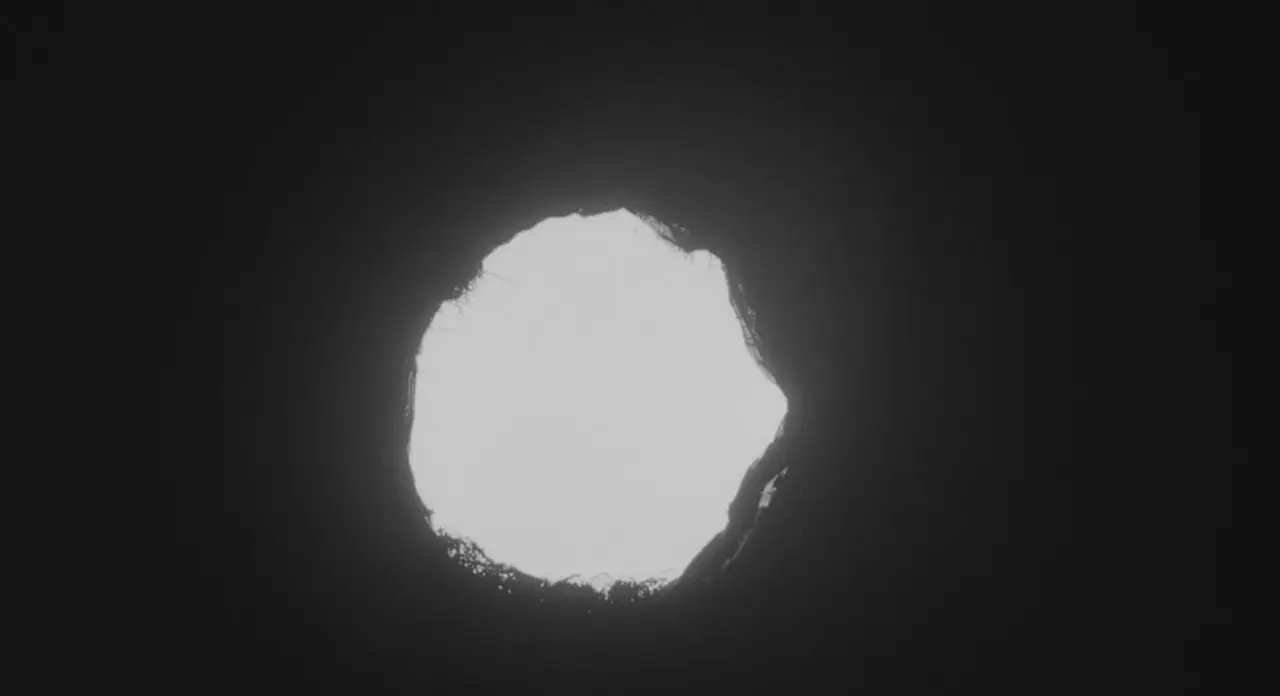
A wasteland stroll and new beginning
Henry’s life will not be the same going forward. He says he’s on vacation when asked later and yet, it looks like he was let go. He enters the unknown thereafter through the passage and simulates a long road home by treading up and down dirt mounds; the space between opposites is where the energy flows.
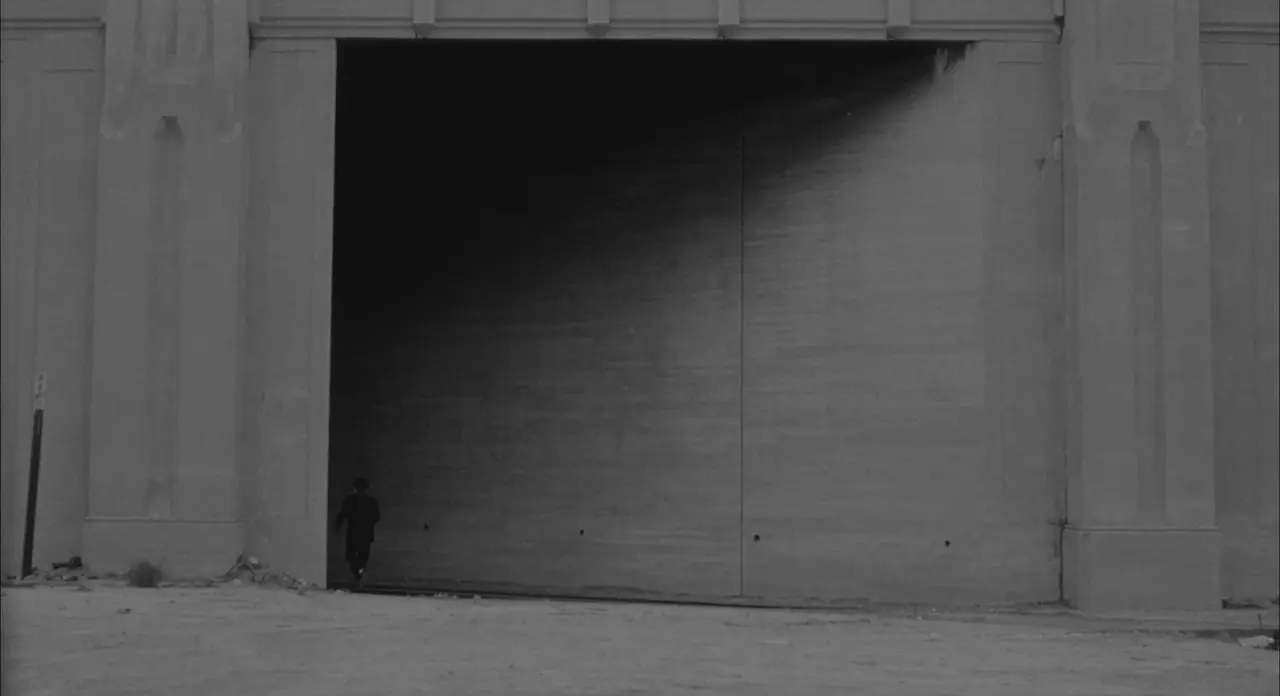
We get a sense of his hometown; it’s utterly dire, artificial, industrialised, lacking character with a sense of abandon. The puddles are dirty and the pipes further depict a sickness and rigidity of this life-giving substance, it forces to tame the flow of nature and life; does not allow it to be. This point is further discussed in the 'dinner' scene.
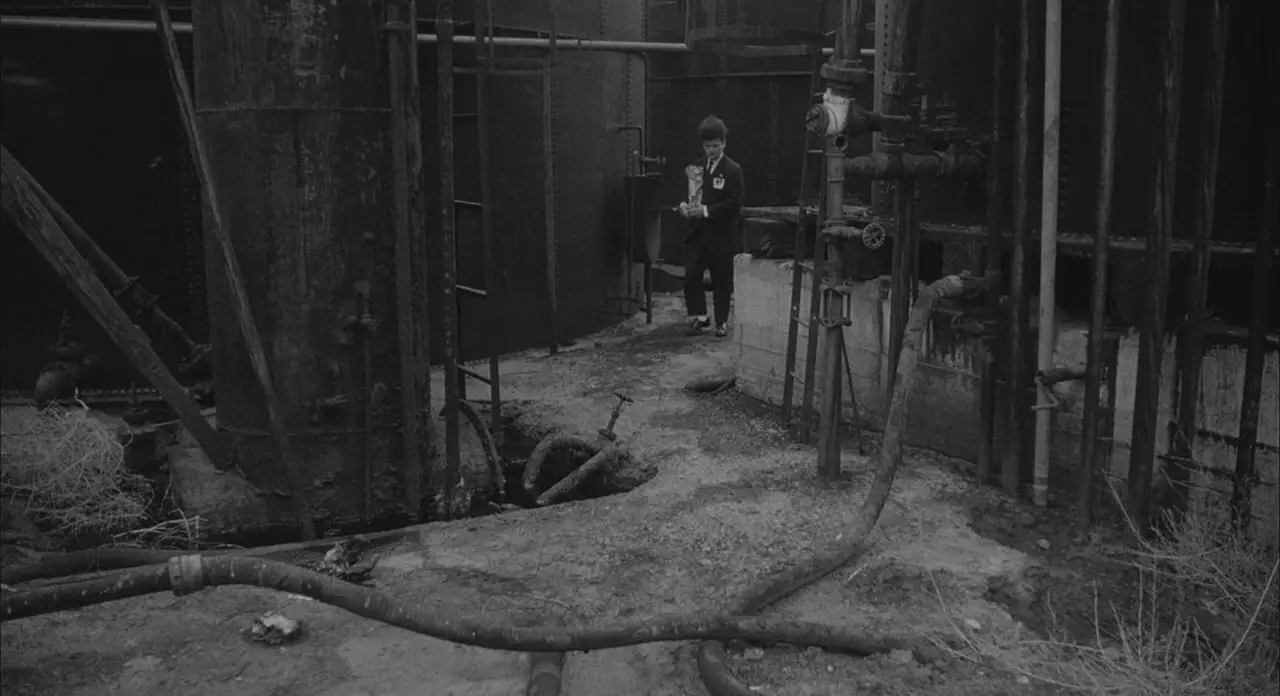
Apartment reveals psychic contents
I will happily note the chevron carpet in the lobby, as an obvious link to the ‘future’ Twin Peaks and its depiction of the Lodge being a place of other-worldliness, alchemical and philosophical intrigue - which points at the trajectory of these thematic ideas proliferating through later works, but I digress!
Let’s look at Henry’s apartment - which he has subsequently arrived at. If we focus on the oddities with a symbolic eye, it is representative of his psychic contents. Lynch, before Eraserhead (1977), worked on this theme of materialising the inner world as outer. This project, Gardenback, did not make it to production. However, it did end up in the short, The Grandmother (1970).
The bedroom where time is spent predominantly hangs a lonely framed picture, and it happens to be of a nuclear mushroom cloud. This symbol becomes vitally important later on in the film with Lady in the Radiator or the anima encounters. I believe we can interpret this symbol as a foreshadowing of the destruction of the ego.
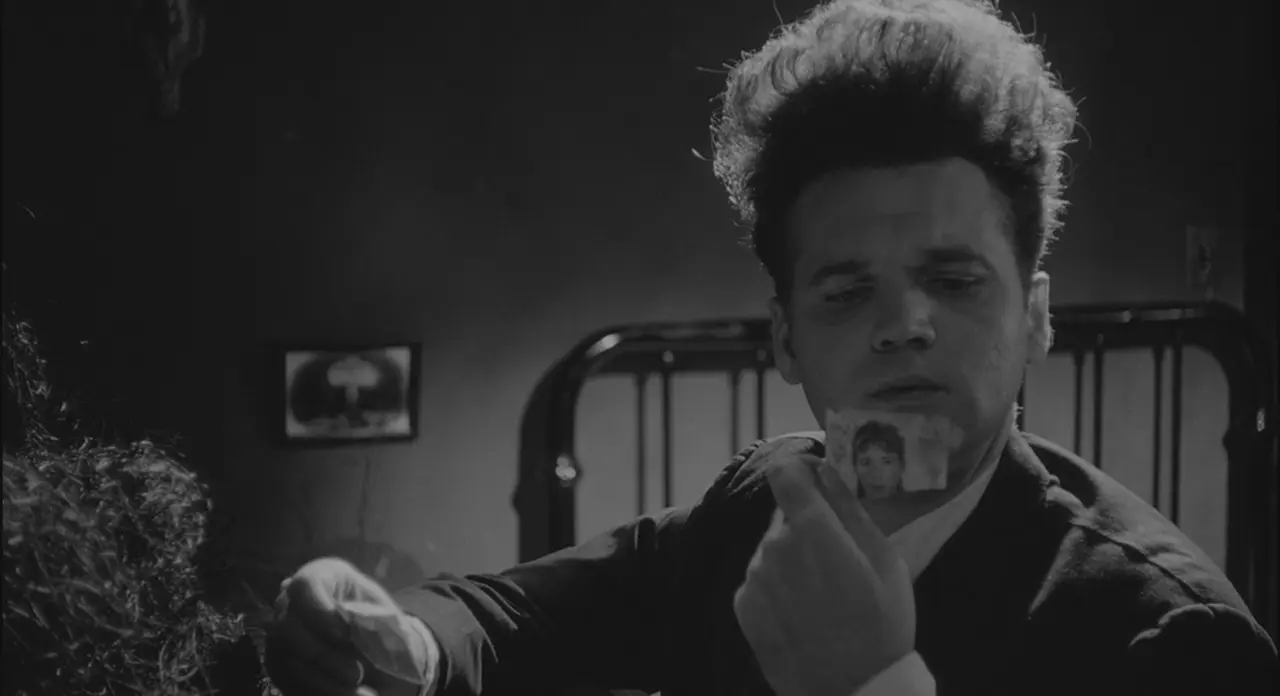
A mound of soil is in neat placement on the bedside table. Branches protrude. An amorphous bundle is atop the dresser or tallboy. Hay-like strands are seated below the radiator. This impression reveals an attempt to work with nature, but the soil is barren and infertile; the grounds of his mind lack vitality and a woman’s touch. There is an obstruction to growth. These are akin to projects, ideas, even relationships, that have ceased to come to fruition. Like a construction site or artist's studio that has not managed to build or create anything of meaning or value. Henry, a printer by trade, is also not indicative of creative endeavour.
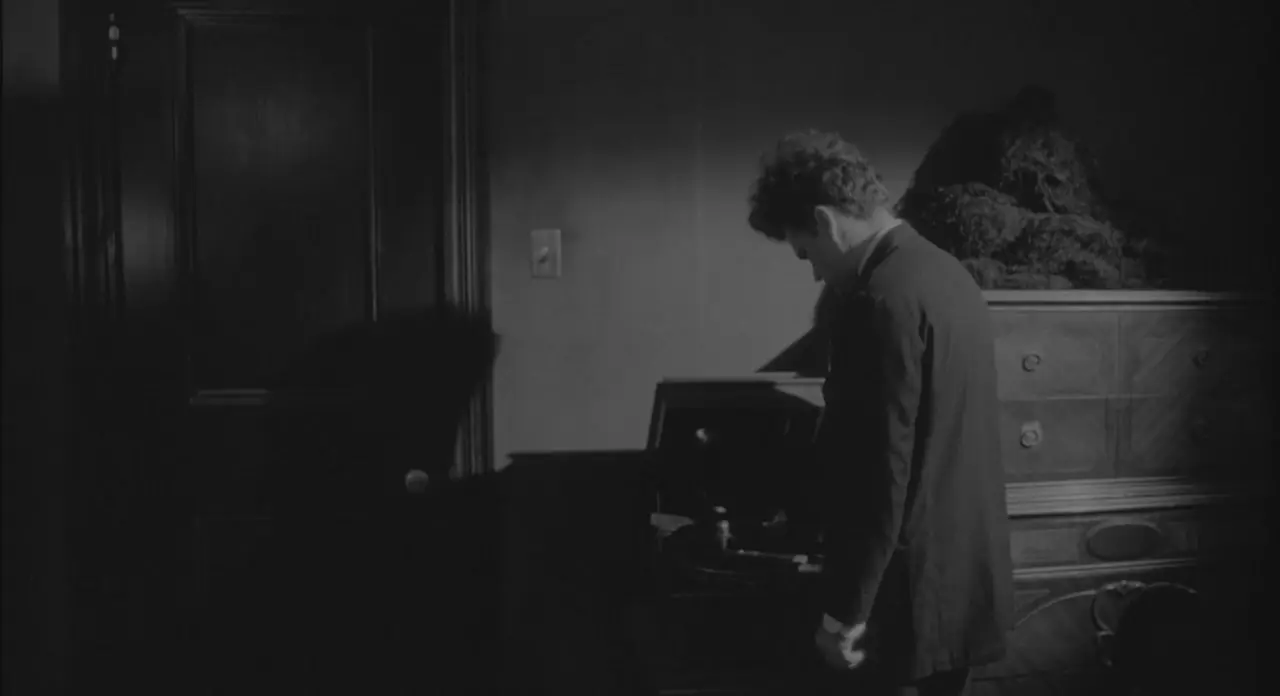
Despite its smaller size and minimal use, the ornamental cabinet next to the dresser has a significant role - as will be seen later. It could be best described as having something just out of conscious grasp, like dealing with symbols or archetypes yet to be understood. Just like synchronicities, dreams, or when events occur in reality that exceed our understanding of the material world, it gets filed away. It is the ungraspable unknown that we come into contact with in our day-to-day. Its placement next to the framed picture of the nuclear blast also has a slight knowing hint that, through this gnosis, a greater consciousness could be achieved.
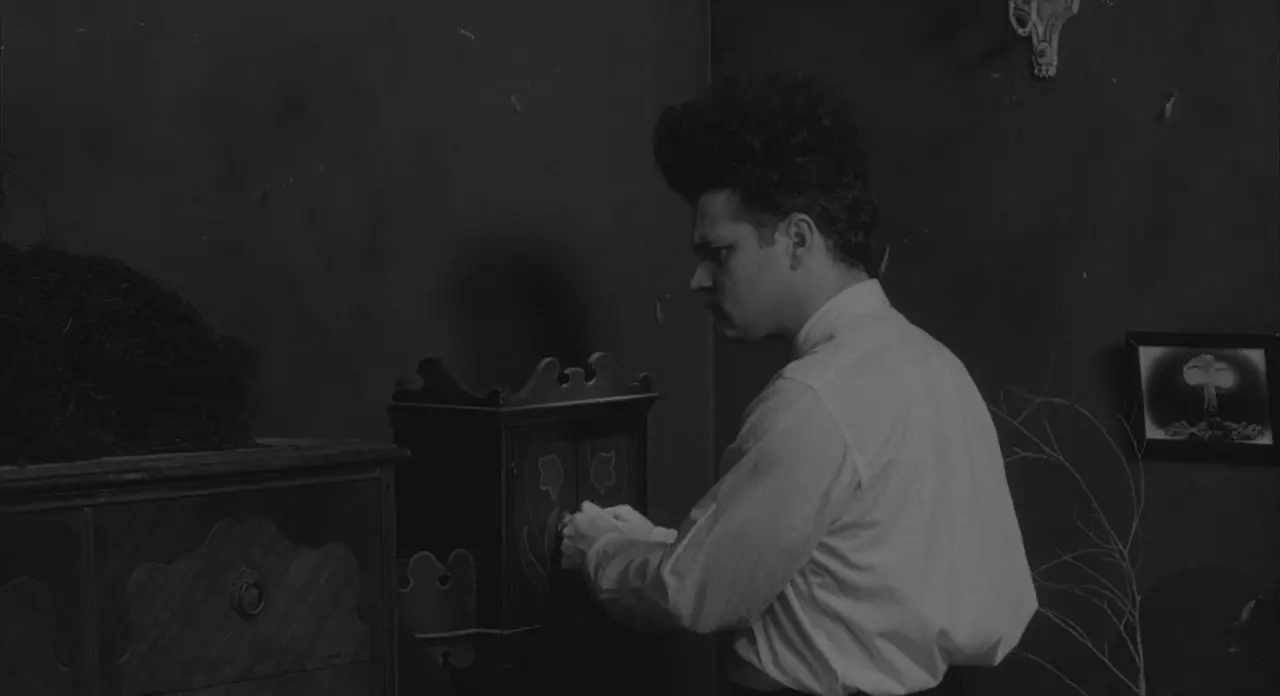
Later in the movie, a crescent-shaped item or worm will be stored here. It creates a portal to the unconscious. When asked who sent the worm to Henry in the film (since this is a point of absolute mystery), Lynch responds with this in turn:
DL: ... But it was in my mind sent to him. In a way it’s like, sometimes you get a message, and it sits, you know, for quite a while, and then suddenly it starts coming into your conscious mind. And in a way that’s what’s happening there. (Richard A. Barney, David Lynch: Interviews, p. 15)
Lonely heart
Inside the dresser; Henry pops coins into a bowl, evidently, there are other coins. It’s as though he makes a wish or makes a small donation to the gods for the events to follow. He rummages for the photo of Mary, whom he must meet for dinner - as told by his neighbour across the hall.
The photo is torn in half, symbolic of his own ‘incompleteness’, without access to his feminine aspect or anima. There is a longing to reconnect with her, even though the relationship had fizzled.
The framing and juxtaposition in this shot reveal this notion, as he holds the picture pieces back together with the mushroom cloud in view. However, what comes towards the end of the film is nothing short of catastrophic, since “Nuclear explosions, you know, are miniature suns”. (Edward Edinger, The Mysterium Lectures, p. 89) The force and explosive power of coming into consciousness is destructive, yet a catalyst for transformation.
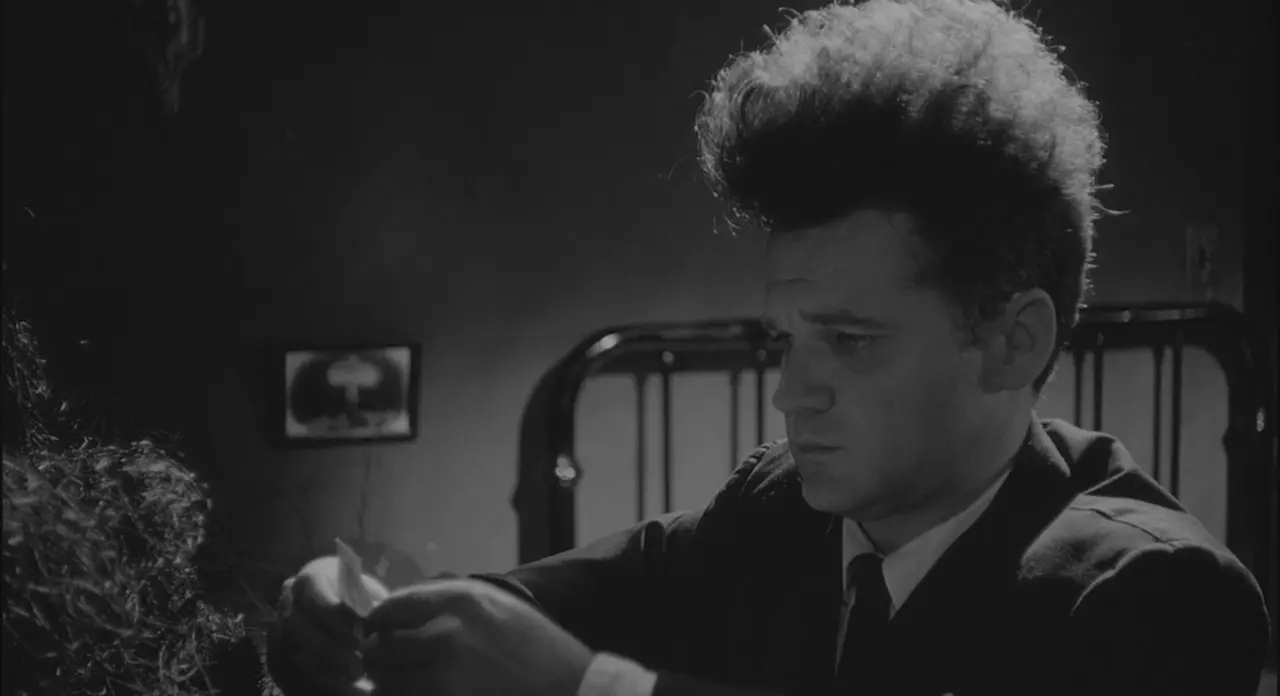
Meeting the family, a portrait of sickness
Henry treads on train tracks to reach Mary’s home – a crossing into the unknown amidst the sounds of chaos. Little does he know of the revelation that will take place. Surrounded by smoke and artificial plants, Henry confronts Mary about her absence. We now confirm the torn photo was Henry’s emotional response to her detachment. Henry is pained, but Mary doesn’t provide any explanation; furthermore, it is her mother who divulges the news of the birth, not herself.
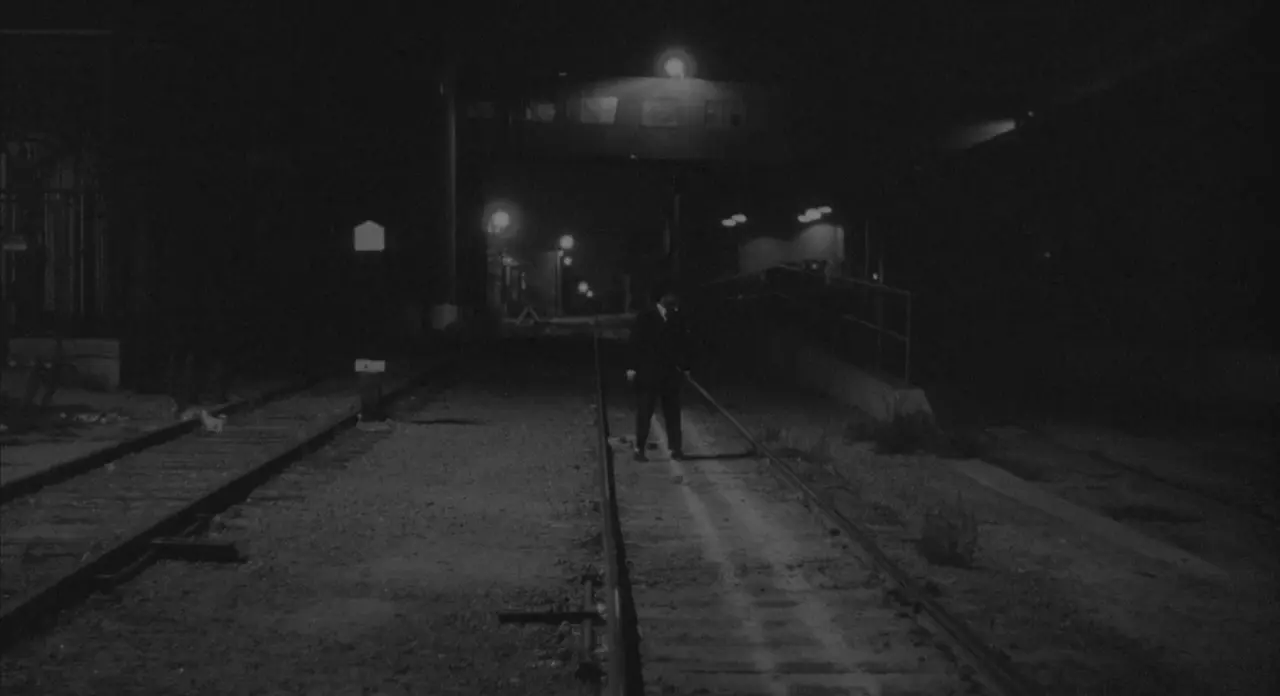

Meeting Mrs X presents an awkward tension between the characters. Henry attempts to mimic confidence and put his best foot forward amidst the sound of ravenous suckling pups. Adding to the aura of bizarre, Mary has an episode, which will be discussed in a moment.
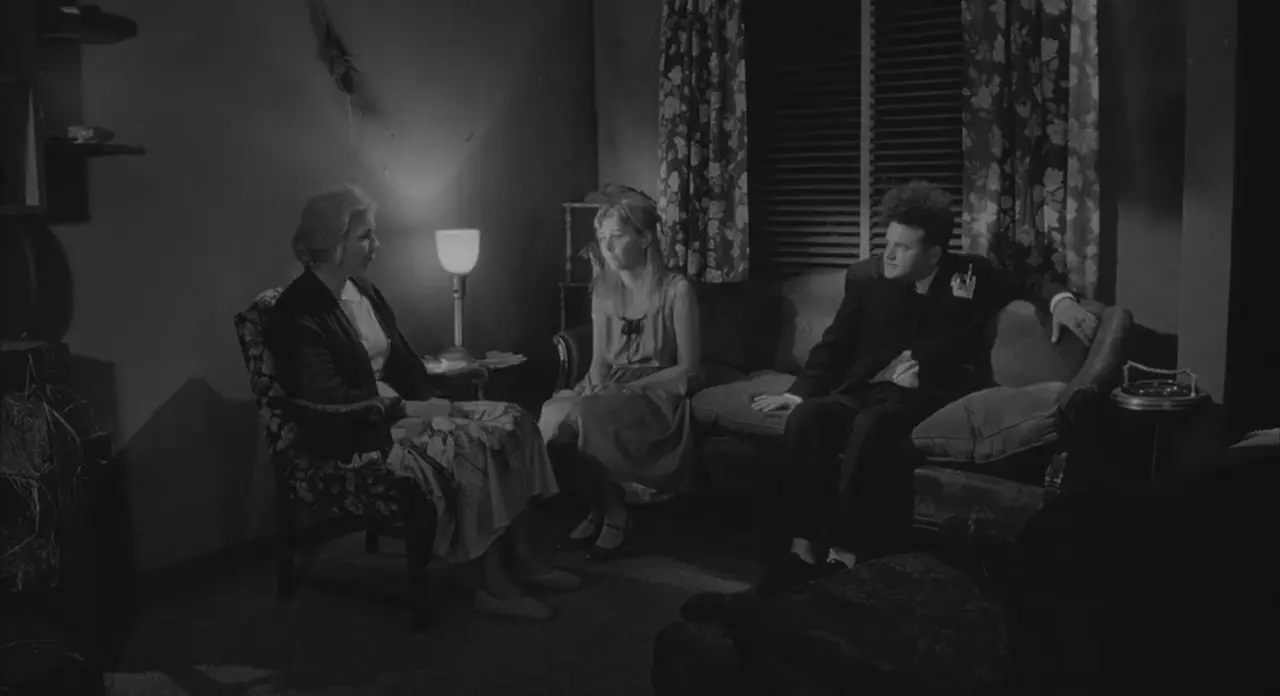
Mr X, providing welcomed tension relief with his explosive entrance, unfortunately, represents the troubled state of the masculine drive and ego. He forges on, building pipes, aiding in the chaos, noise, and ugliness that surround them, and lacking any self-awareness that he has become the problem. He represents this man-made drive that disregards nature and harmony in favour of progress and industrialised growth. Eventually, his tirade is drowned out by the ambient noise and is finally barked out of the room by the dog. This theme is further represented in his excitement to cook and serve “man-made chickens”, which proceed to ooze a black liquid at the table. The lifeblood of this environment and everything it produces is a simmering monstrosity. There is an attempt to beautify the home, but it remains futile for all involved.
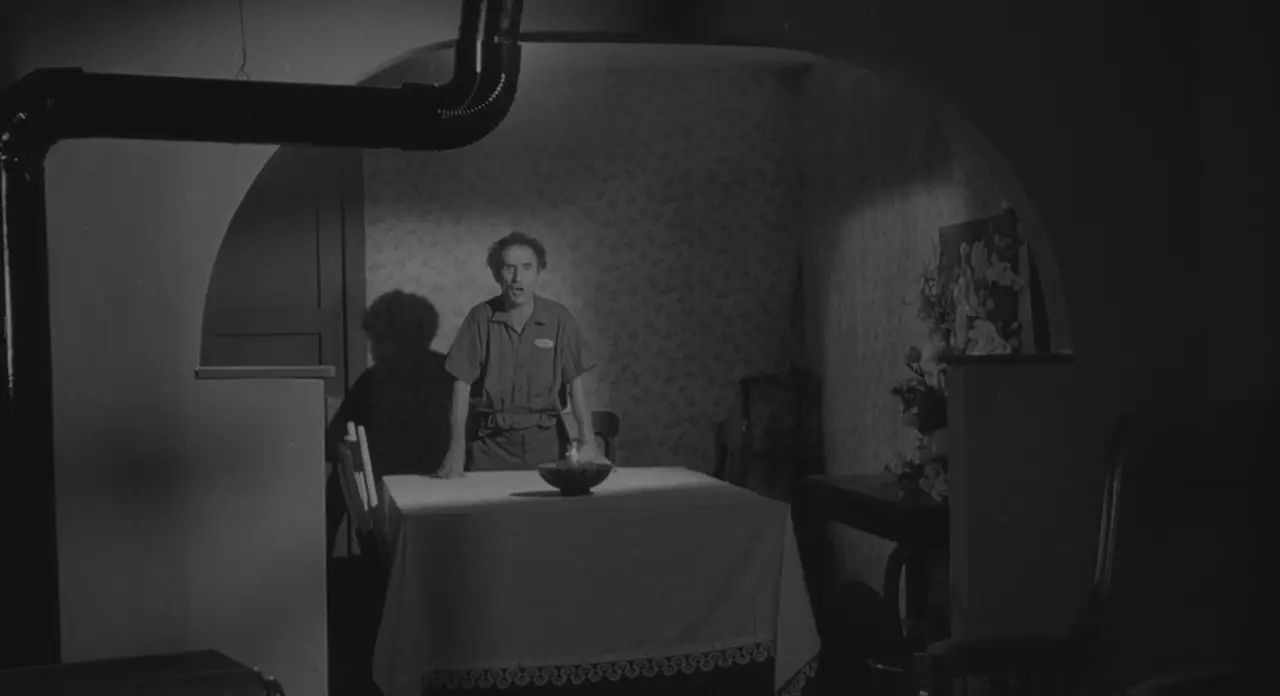
All the women in the X family largely present as unconscious; both Mary and her mother, Mrs X, have an affliction that appears to be a cognitive aberration. There is a sense that their conscious behaviour or level of consciousness is just above the primal dimension when the episodes happen. Additionally, it occurs specifically when there is a hint of unarticulated tension that arises: the women automatically regress into a shielded state, which protects them from the sickness of their domestic reality, a defence mechanism.
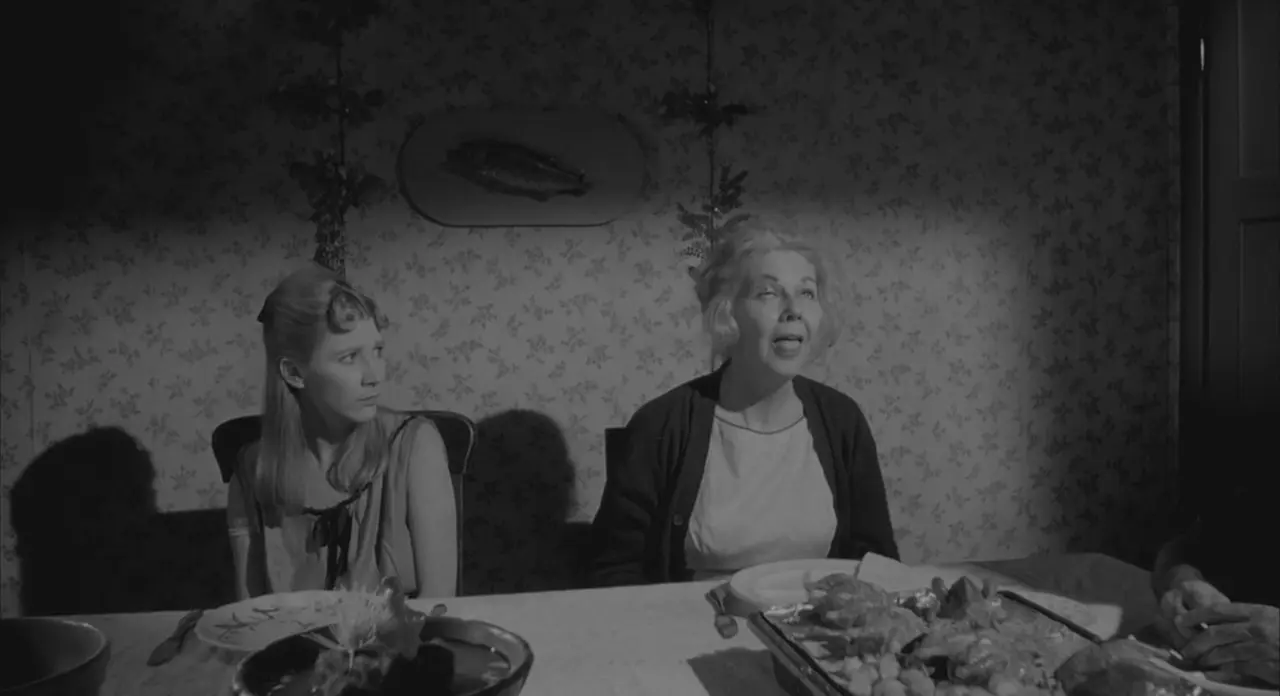
Mary’s episodes are not as intense as her mother’s, but it may be her trajectory, and if that was not horrific enough, Mary’s completely docile Grandmother sat in the kitchen, artificially kept going via cigarettes (spirit) lit by her daughter. She epitomises the fate of all the X women if no conscious development occurs.
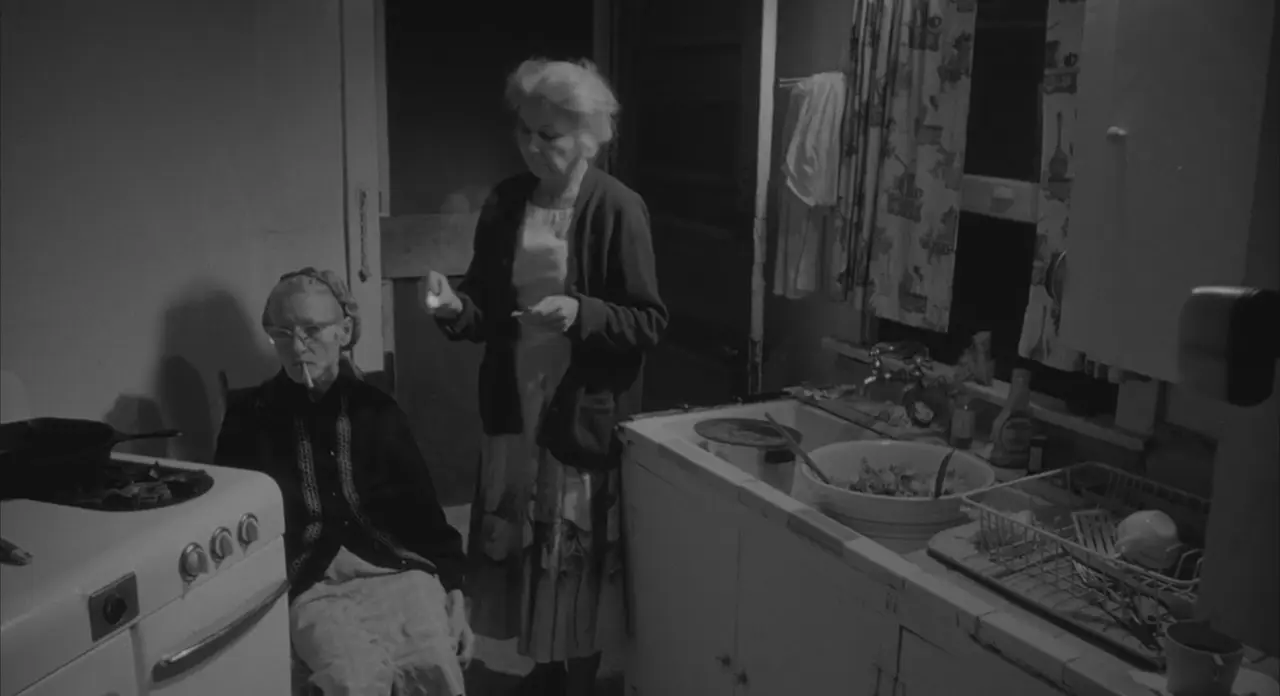
It’s alive!
After Mary told her mother the bombshell news that her baby’s father is Henry. Mrs X sniffs him, which further shows an animalistic, unconscious quality concerning the above split dimension of the personality; it is almost desirous of what Henry has – the potential active dimension of the masculine that is missing from her husband, Mr X, and perhaps her own inner life.
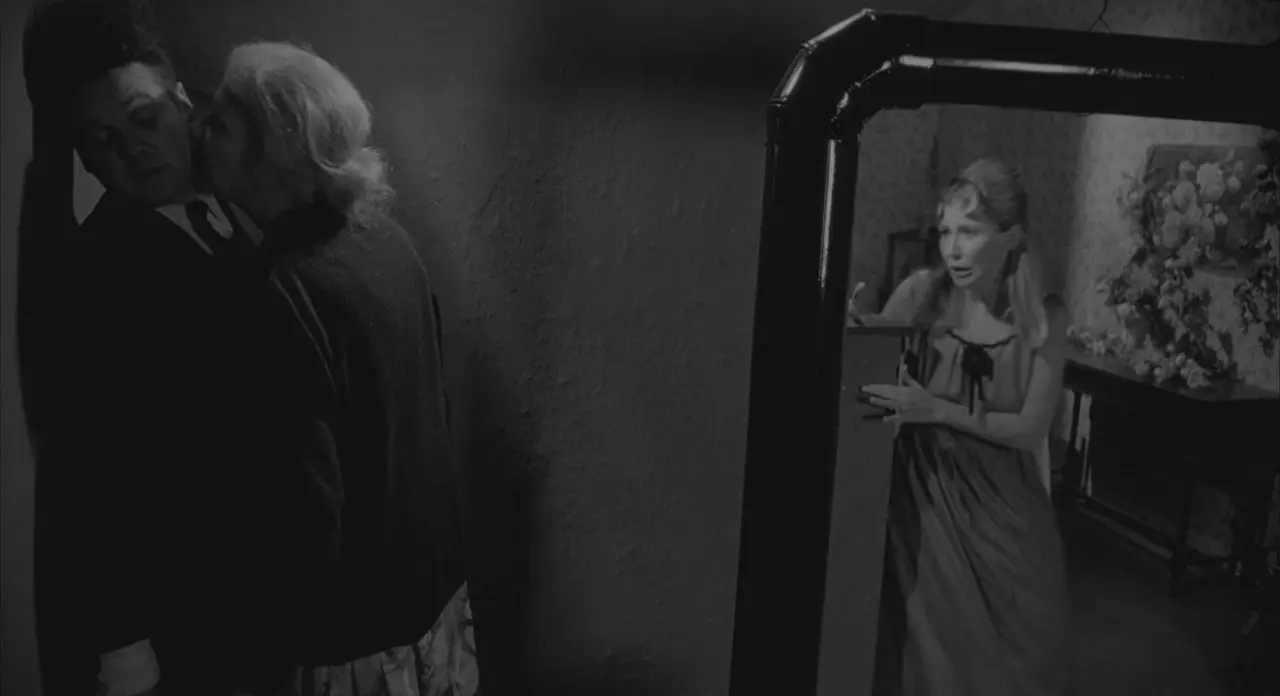
It is revealed: Mary and Henry’s dalliances have resulted in a baby out of wedlock. I hold strongly to the line by Mary, “It’s still unsure it is a baby.” as a prominent exposition for the entirety of the film, and its key to understanding it.
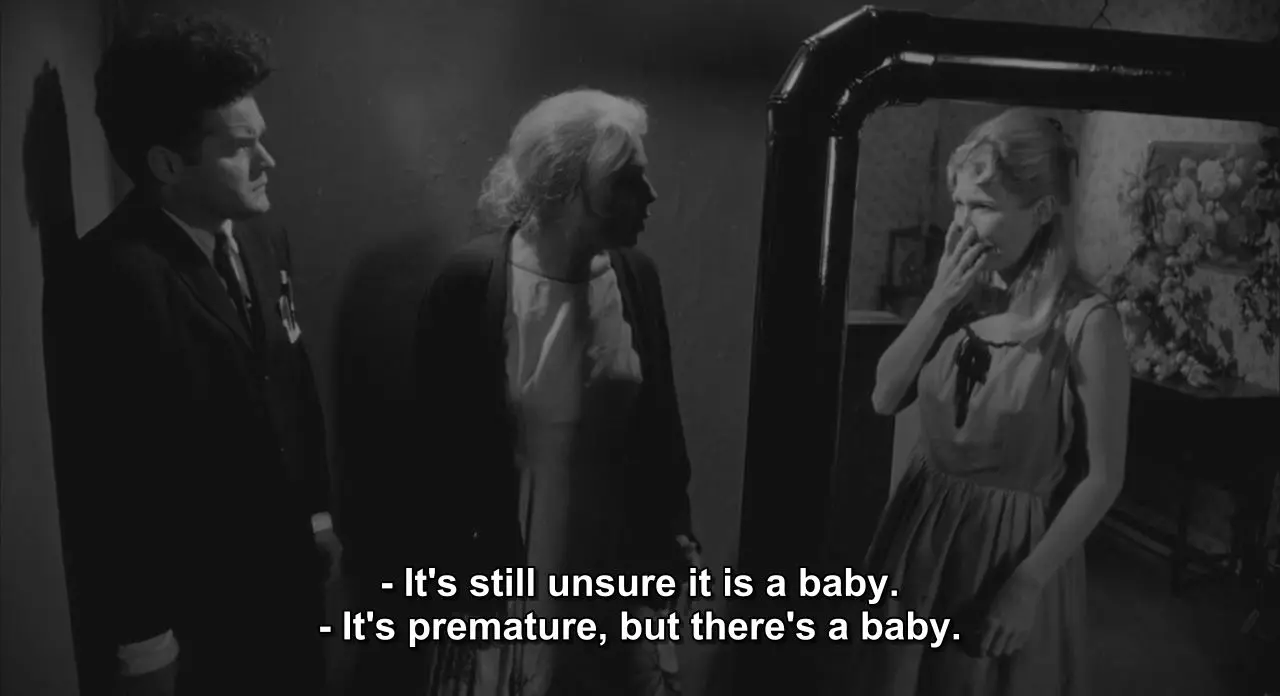
It is worth paying a note to the nosebleed, since this solidifies a physical and mental substantiation of the shocking revelation to Henry, his body reacts. The dog mother, oblivious to the drama, allows her pups to suckle throughout it all, which is the plainest picture of nature’s directive.
A ‘baby’ needs care and attention
After Henry agrees to marry Mary, they settle with the infant-like entity in his apartment. Additionally, Henry receives mail, inside the package is a crescent-shaped item, later animated to be worm-like.
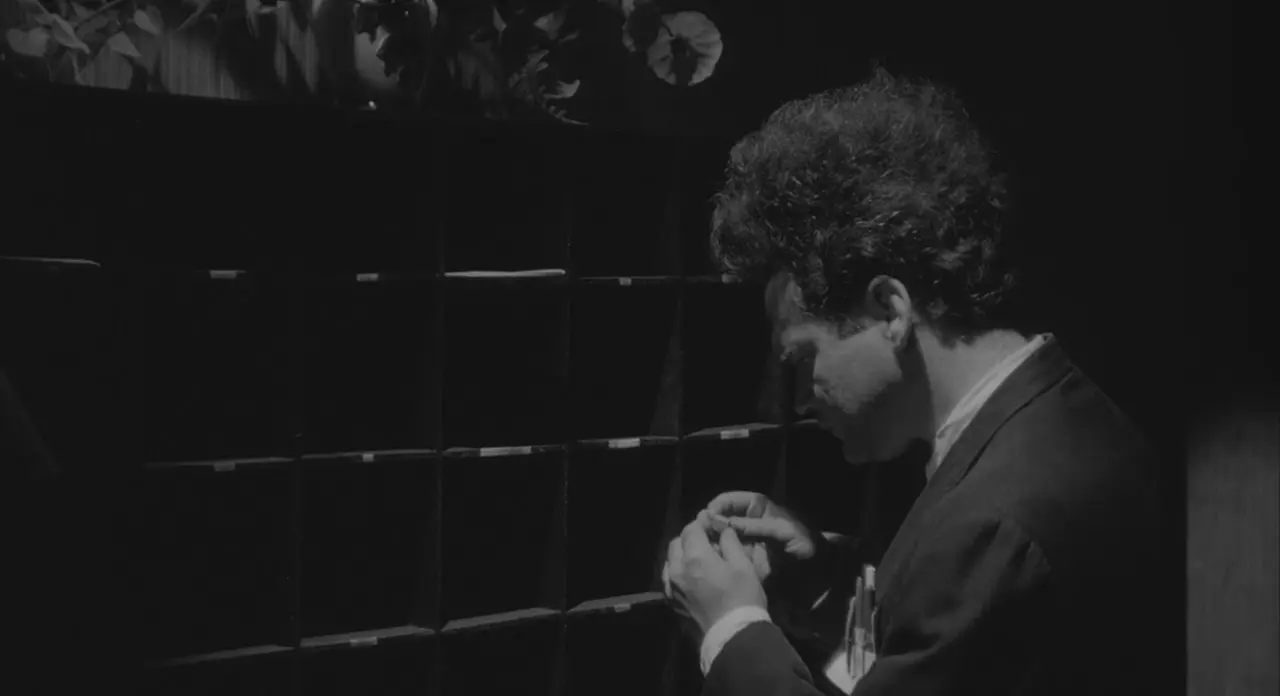
Let’s now take a look at this infant-like entity, so named off film, ‘Spike’, in a symbolic lens. Spike has a strong association with the moon rock seen at the beginning of the film, since it is there at birth and cracks, at, for all intents and purposes, death. We could very well surmise the entity is born into this horrid existence to bring awareness to what is held within the rock. It is something to pay attention to, the elephant in the room.
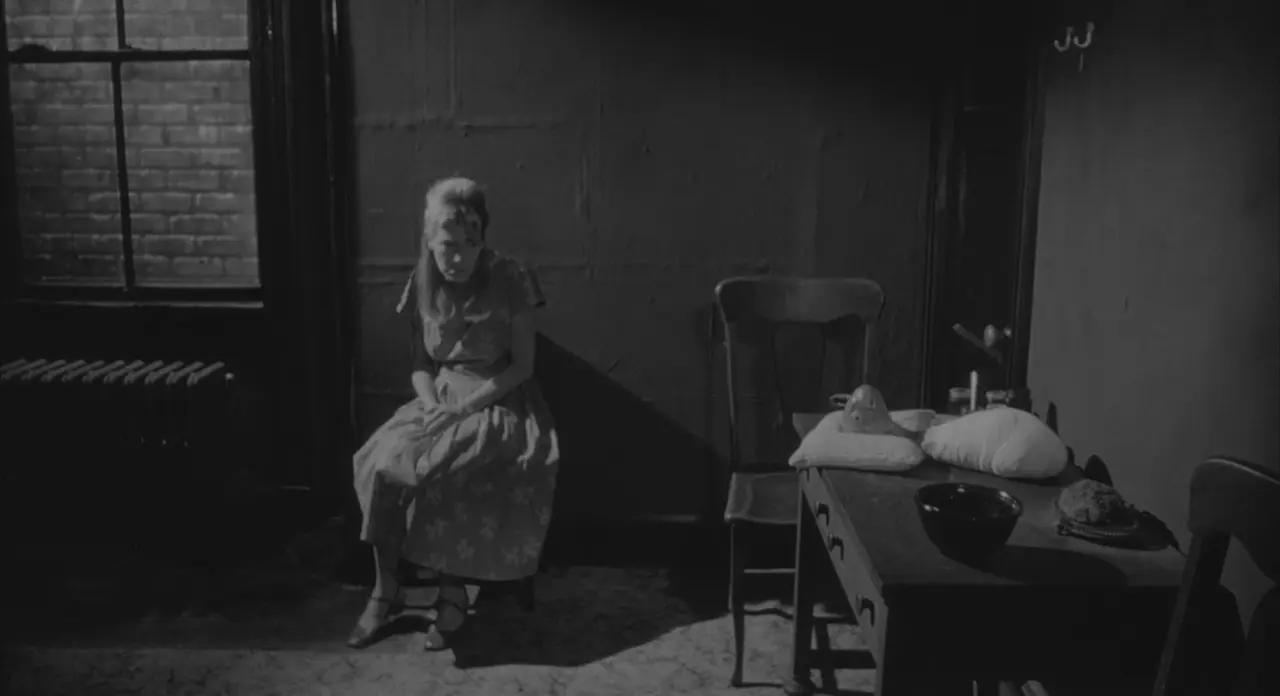
It is a new addition to Henry’s apartment and the only ‘living potential’ that exists, besides Mary herself. If we perceive his apartment as holding psychic contents, Spike is a representation of something like a living project ripe for evolution. Psychologically, the child is the future potential of the personality.
The nurturing by Mary, difficult at first, but eventually accepting food with ease from her, shows relationship potential and, since it is a part of Henry - responds well to him. What becomes evident is that the conscious and active presence of these co-creators is necessary for the evolution of the entity that is inside Henry, but it goes awry, as the events to come with Mary reveal.
In possession of the worm item, Henry can unlock something that was closed to him before, like a new gift of awareness. This is evident now, upon his arrival home with a jovial demeanour; he rests comfortably on the bed, is briefly alerted to the baby reacting to a food item, noting his interest and care of the creature; then returns to his mindful state - this infamously brings us to the radiator.
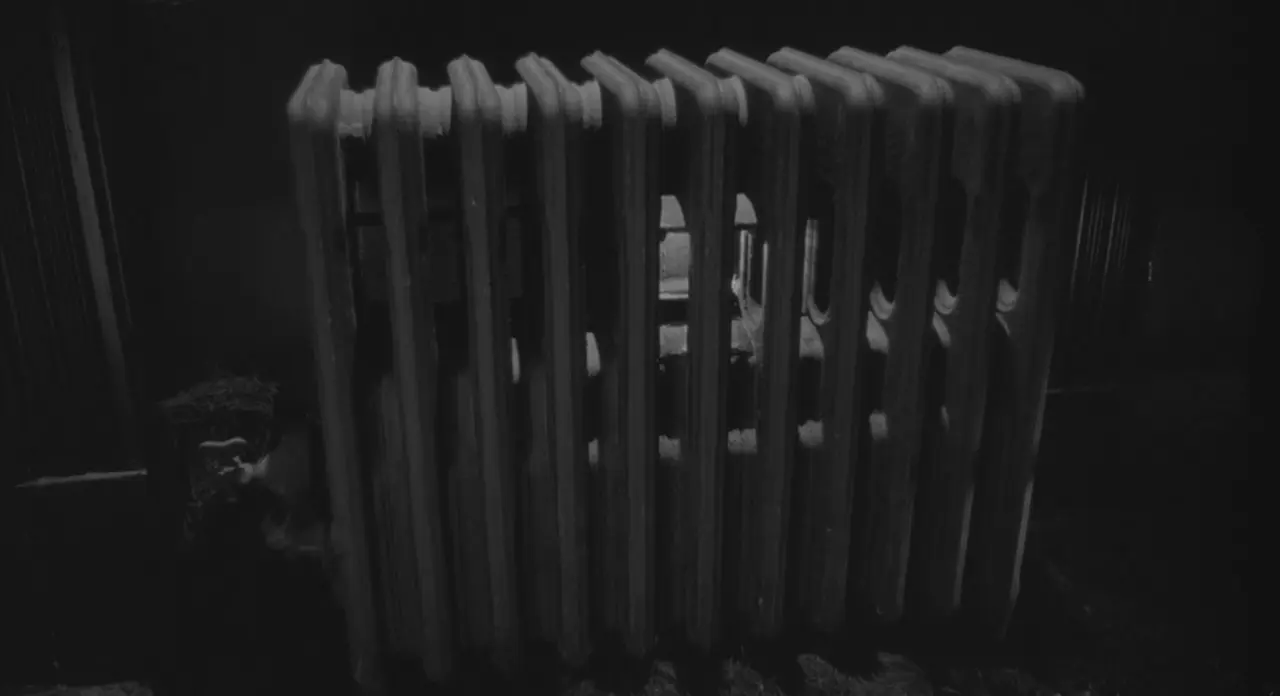
Radiating lunar consciousness
The radiator represents the water source - Henry’s gateway into the unconscious, through meditation or active imagination. It provides the pivotal and immensely captivating, dream-like, otherworldly sequences and interactions throughout the film, and when looked at keenly with a symbolic eye, one can parse out the language. I want to stress that this personal development has been achieved only because the birth has been allowed to take place by the self, and upon reception of the worm item. This worm is linked to the round rock in the unconscious, which is representative of the closed part within Henry, all to be discussed further later.
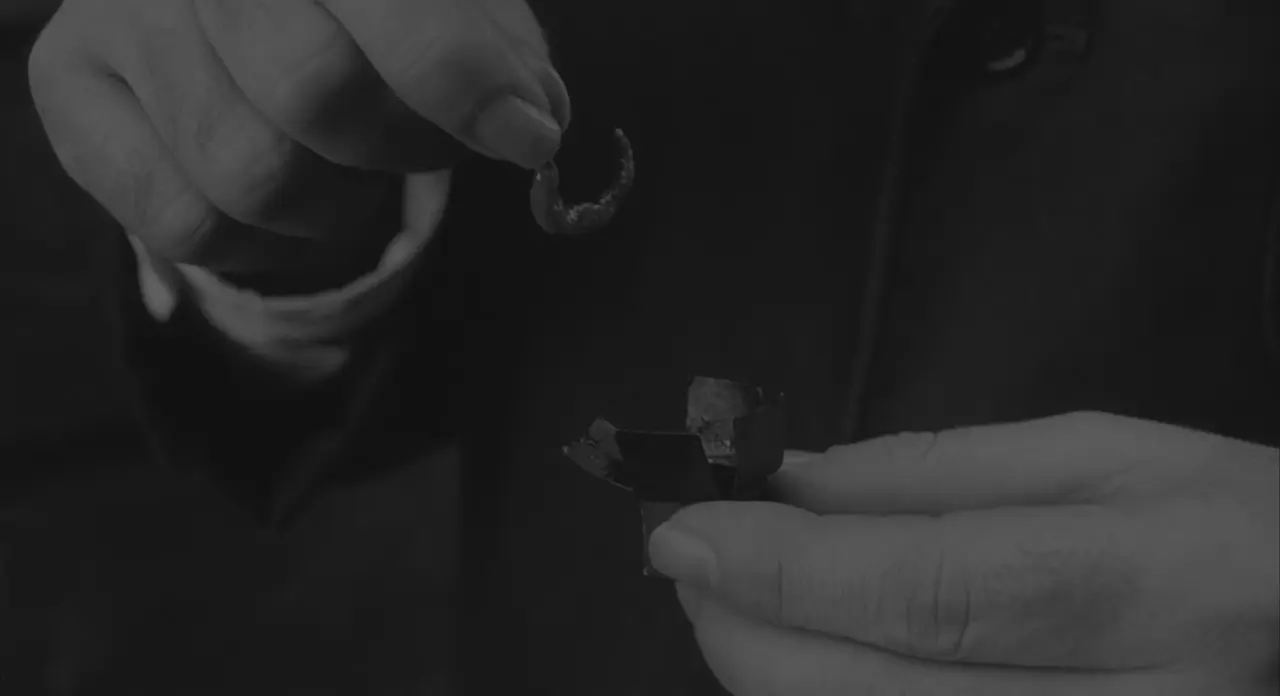
Henry’s first foray into his daydream, meditation or active imagination, opens with a spotlight on a theatre stage. It’s interesting to note here, Lynch had also begun practising Transcendental Meditation in search of spirituality, at the same time as filming. The creative and specific colouring or influence this had on his career and life is no doubt profound and immeasurable.
Coming back to Henry, the visualisations he encounters start gradually, and here he only gets a glimpse of what’s to come. A film within a film, or a life within a life, presenting a deeply layered substructure of the unconscious that one can actively participate with conscious awareness.
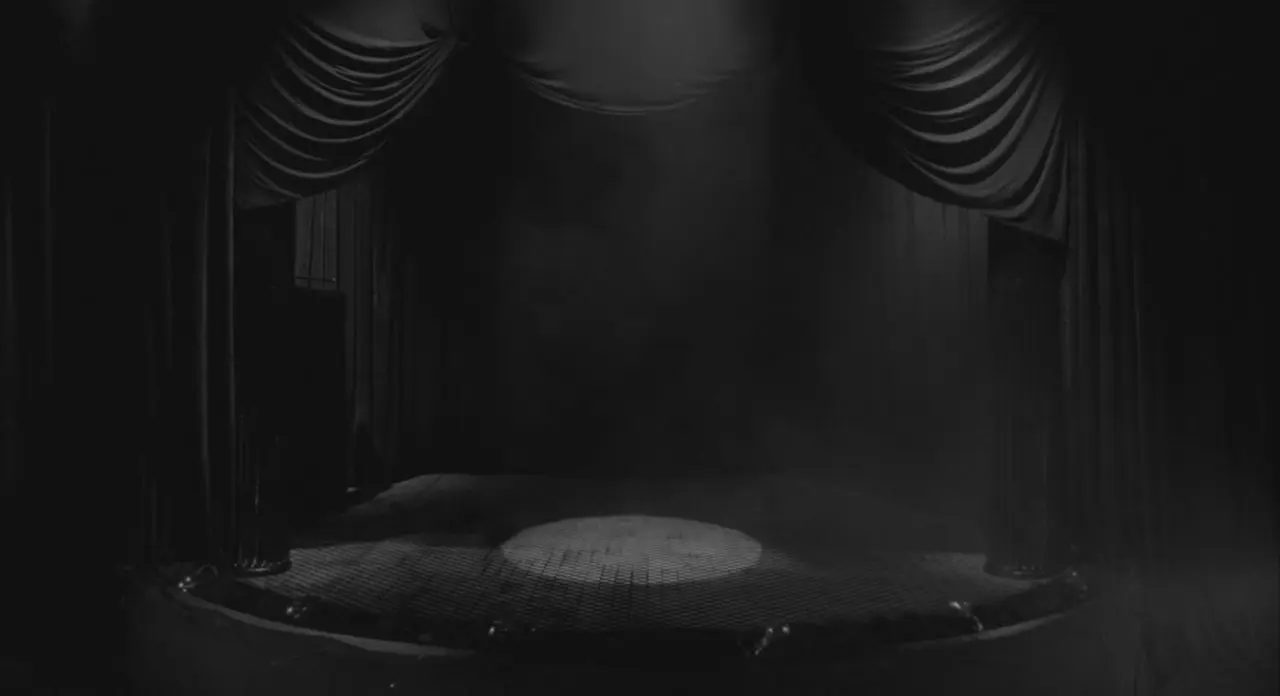
Mary’s sleepless night, a closer look
By nightfall, Henry is now able to secret away the received item from his jacket pocket, placing it in the little cupboard near the bed. Just like placing it in the back of the mind.
Sound is used prominently by Lynch throughout; however, I only now feel the need to hone in on its use at present, since it allows us to get a sense of the relationships and connections at play with Spike. However, I would be remiss not to tie the turbulent sounds of the wind and rain as a magnification of Mary’s silent turmoil.
During the process of Henry hiding the item, Spike is quiet. Once Henry is in bed, it begins to cry softly, as though in need of attention. Henry, while in bed with Mary, takes the lead and attempts to touch her for connection or romance at its most basic. She refuses his advances, and now we have Henry’s perspective on the bed. One could call a vision of truth, there on the pillow by Mary’s hair, a twig. A symbolic representation of the futility of their relationship, it is barren, nothing further can grow; a connection to the same material found on his room furnishings and stark with the same meaning. Henry falls asleep.
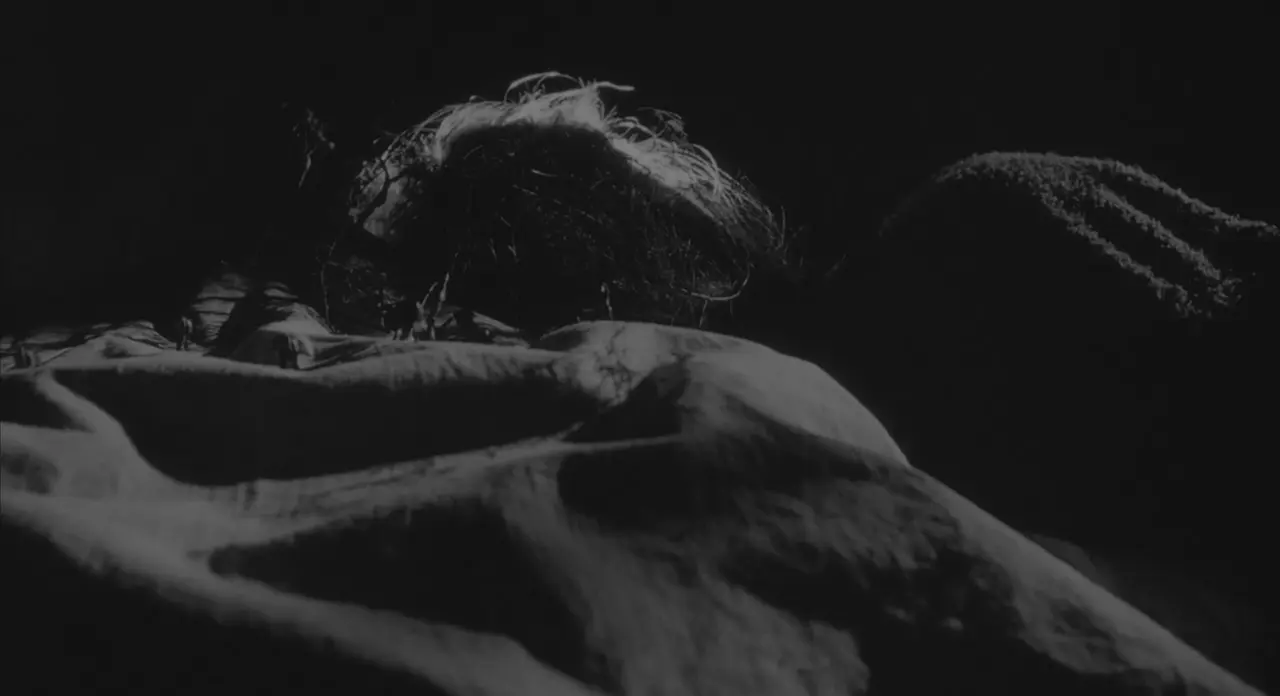
Mary, however, is in a state of exhaustion and frustration; perhaps feeling sorry for herself and her situation. Imposing a marriage for the sake of her reputation and being stuck with this abhorrent creature - or an immature aspect of the masculine. From Mary’s perspective, the relationship and responsibility are unbearable, all culminating in the infant-like entity that cries incessantly. She jumps out of bed and switches the light on, waking Henry in the process. Somehow, he was sleeping soundly through the noise. She stands in opposition and proceeds to yell at the source of her pain. She exclaims her leaving after not being able to get any sleep, but it’s obvious that it goes much deeper than this excuse when it is clear she will not be back. And just as her introduction, we are left with her immature aspect; running at signs of trouble, unable to communicate and a regression to her parents. Perhaps her chance of development was not to be with him or her cross to bear, but the regression and fleeing of responsibility still reflects poorly given her circumstances.
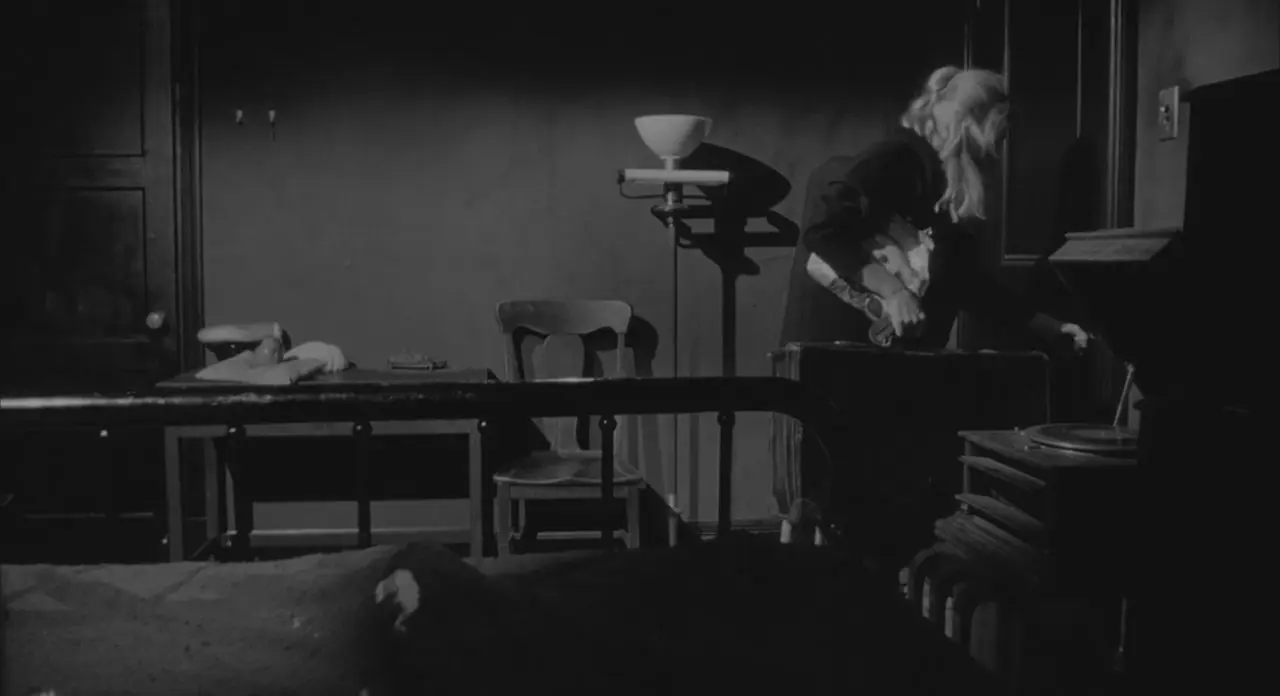
Oh, you are sick!
Henry, now with full responsibility, lies awake ruminating. He begins to notice a change in the breath of Spike and after checking its temperature, we can see a fever is coming on. Not completely sure of his assessment, Henry turns his back and looks again. We are immediately presented with a spotty, sickly, even more grotesque-looking creature. To zoom out a tad, there is a direct connection between Spike’s sickness and Mary’s leaving. Without her, the infant-like entity cannot evolve. What it tells us now is that we need to have the presence of both.
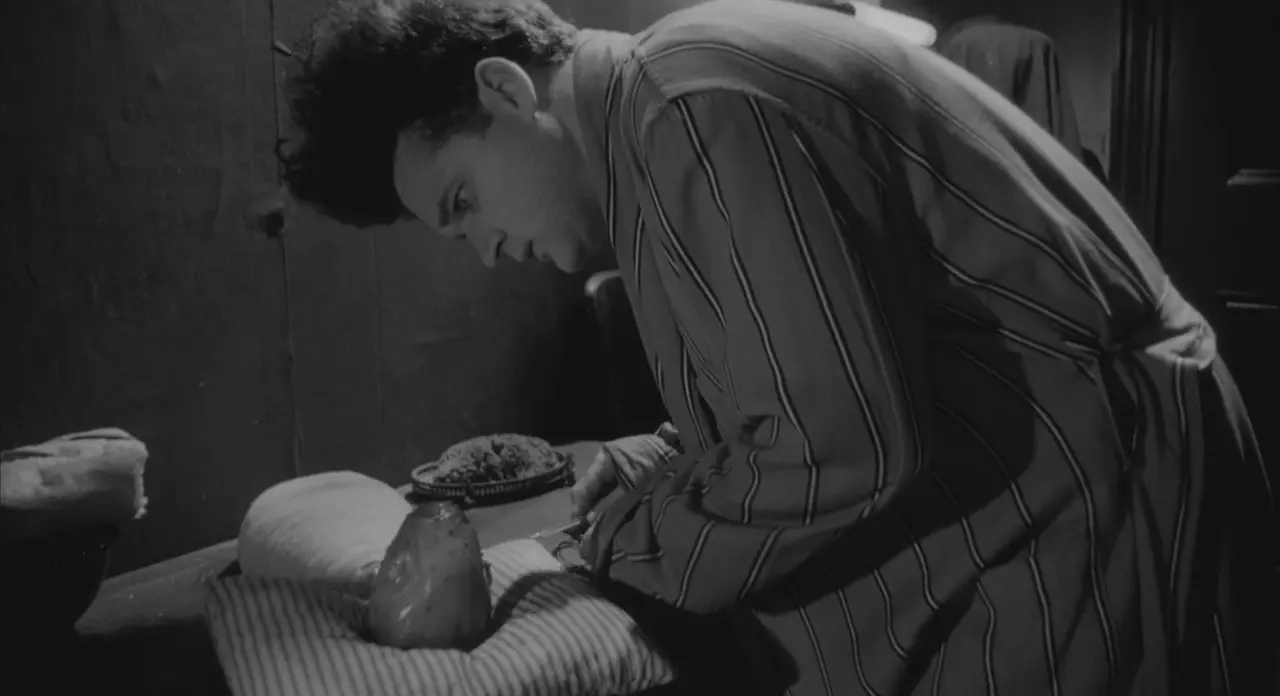
Henry adds a vapouriser on the table next to Spike, in hopes of some congestion relief. My sense is that it is on ‘life support’. Henry is forced to stay still for a time. In this self-reflection, he recalls the item in the little cupboard he received by mail and thinks there may be another gift. Henry conflates the receiving of an item with another one; he does not know that this is all he needs, nor that the ball is in his court for conscious action.
Upon opening the door to leave, Spike is immediately upset. It is made clear that Henry cannot leave; he must pay attention to what’s at hand, what’s in his psyche and this infant-like entity calls for attention. Henry must sit with himself and endure, instead of attempting to escape.
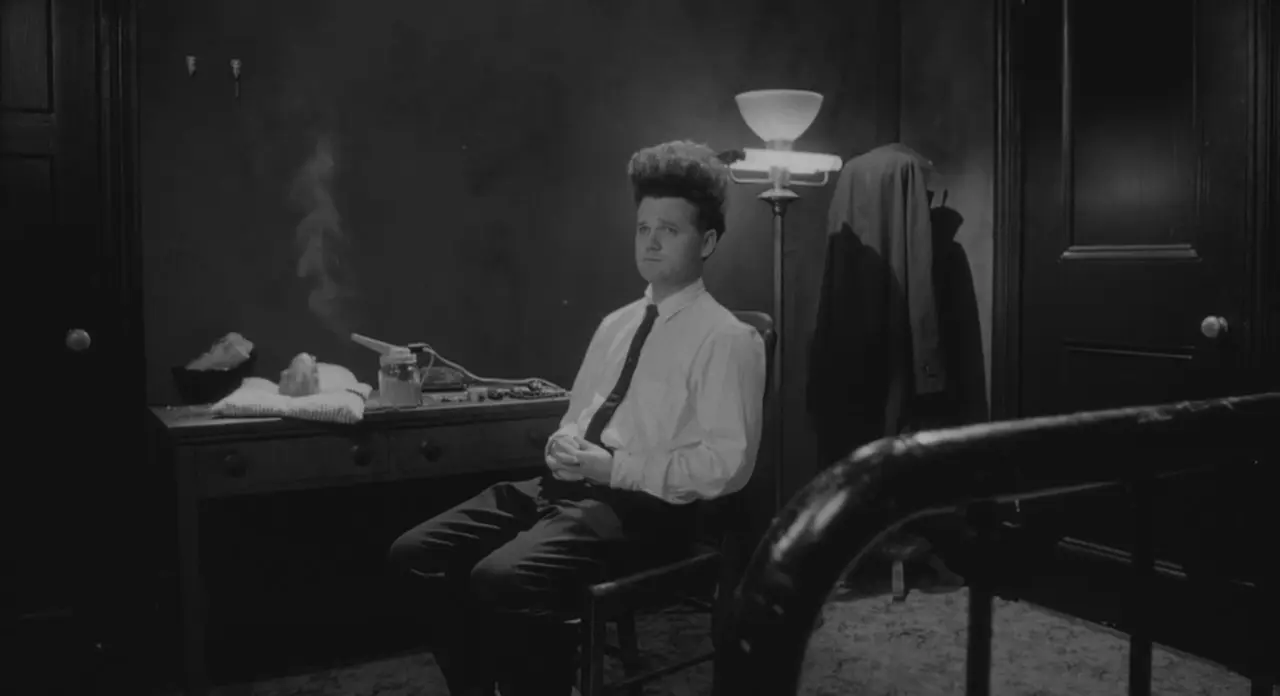
It is only by nightfall that Henry can access a part of his unconscious that has been waiting on the sidelines, in a state of restlessness and concern, he stares toward the radiator.
Death from above
Globe lights line the stage and turn on, one by one. Promoting an idea of awakening and attention, to the woman that appears; the anima (meaning soul) or feminine counterpart within his psyche.

Lady in the Radiator (Lady) does a little timid but excited side-step dance around the stage. She is met with falling sperm-like creatures, similar to Henry’s living infant-like entity atop his table. However, the ones that fall here are dead on arrival. What happens next is quite unexpected and some might say psychotic; Lady begins to muster an unnerving capacity to joyfully squish them with her shoes.
Let’s take a look at this scene a little closer. If Lady is a part of Henry’s psyche and representative of the anima, then she is aware that Henry’s life to this point has been a series of poor choices and failed relationships, his personal development has stalled and nothing has been able to take root and grow – until now; in addition she is finally able to greet him, which explains this nervous shuffle dance - like a news update of their situation.
Each entity that falls from above is established as dead and lifeless; they have already been discarded by the self (Man in the Planet) and are not fit for birth. They are representative of what’s come before, with no hope of transformation. So her joy is centred around the fact that Henry, in communication with her, could lead to new potential within and without. It is one arduous step towards Henry’s personal development and her relationship with him, as a part of him; a celebration after a long spell of stagnation and silence.
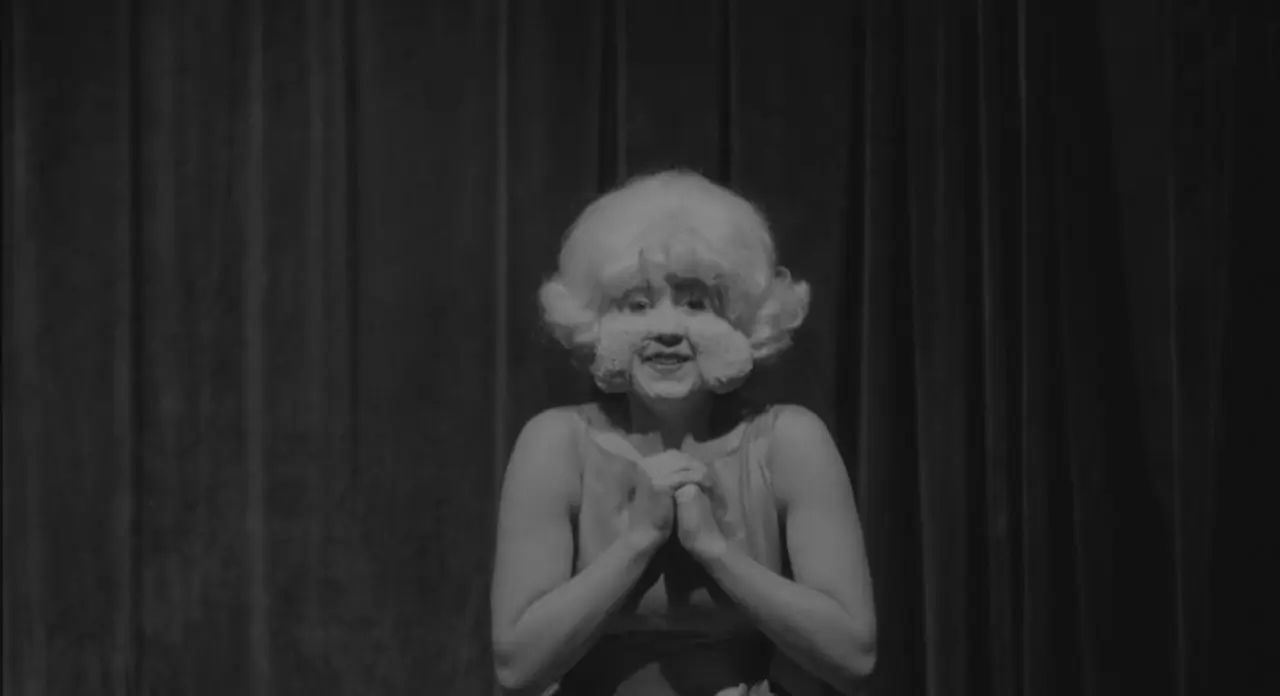
Waking nightmare
What continues straight after is another seemingly nightmarish sequence, wherein we see Henry asleep in bed and now with Mary also. He is woken up by Mary’s movements and continually agitated by losing his place in bed. Eventually, he feels something between them: more dead sperm-like creatures. Mary is completely constricted in the bed sheets – a visualisation of the constricted relationship. Henry, in disgust, grabs and throws the critters against the wall, right next to the cupboard storing the mystery worm. This act is not too dissimilar from what Lady/anima was demonstrating in the active imagination, the difference being the emotional reactions. I wager this dream sequence tries to relay his stale condition to his psychic reality. It also emphasises the co-creation of the infant-like entity with Mary as a failure, doomed from the start.
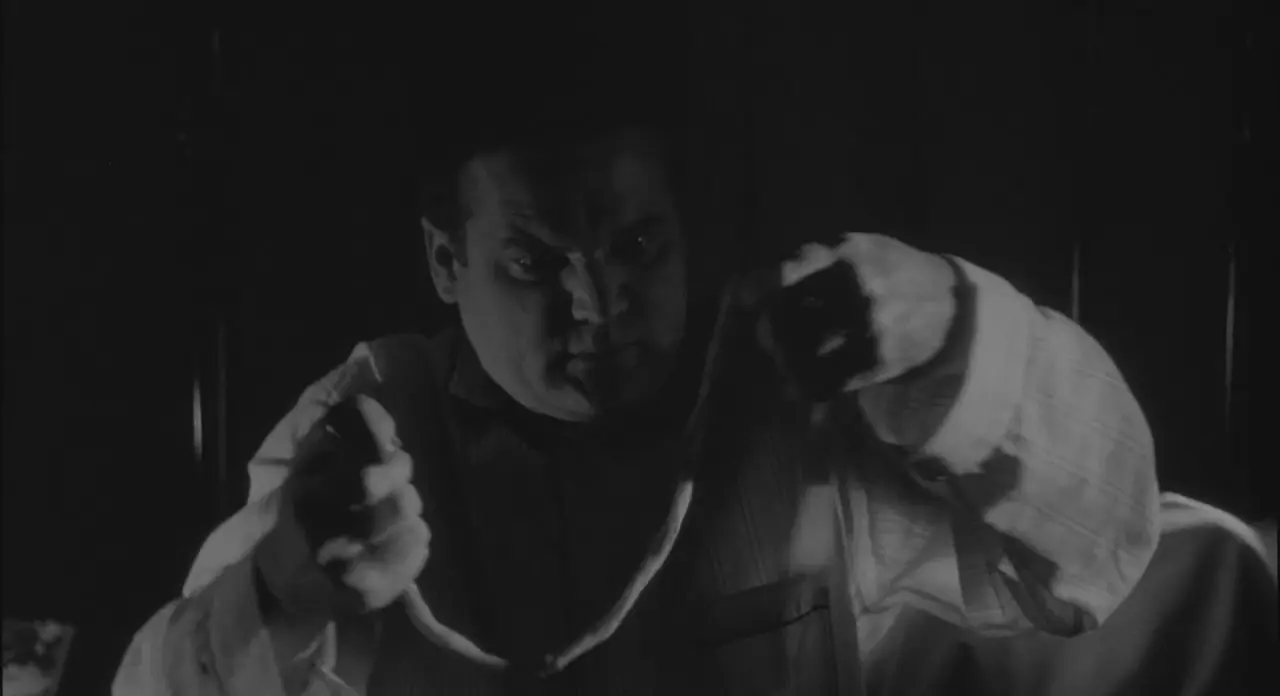
Our attention is now drawn to the little cupboard amidst the drama – a spark of hope lies in the worm item; stored in the cupboard and in the back of the mind, in the unconscious. It squeals and wriggles away from the light and appears directly on the moon rock, which I’ve determined is an aspect of Henry’s psyche that is closed off. The worm playfully taunts and exudes energy. It squeaks, slithers in and out of holes, and looks as though it wants to bring awareness and call attention to the rock.
“The soul is then a “worm” like the “fiery serpent,” a “larva” and a “monster.”’ (Carl G. Jung, Psychology and Alchemy, par 215)
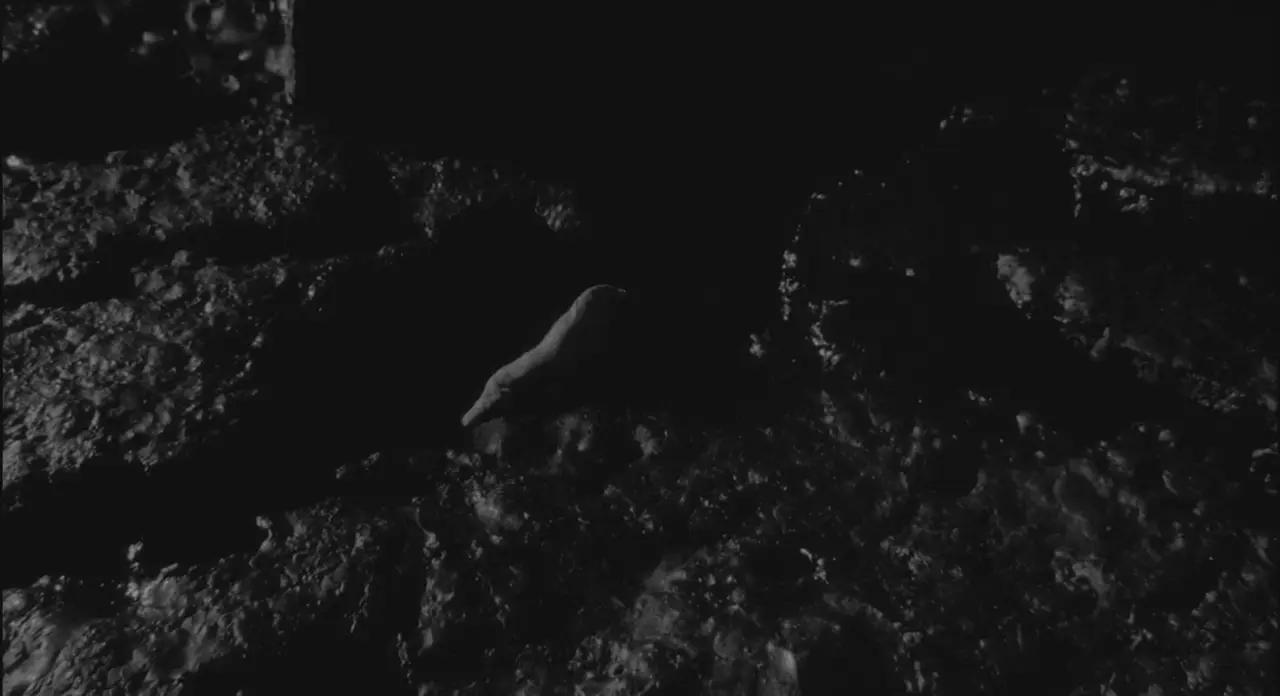
Finally, it stops and opens itself up to form a portal or conscious connection to Henry's psyche; where he is now awake and sitting on his bed.
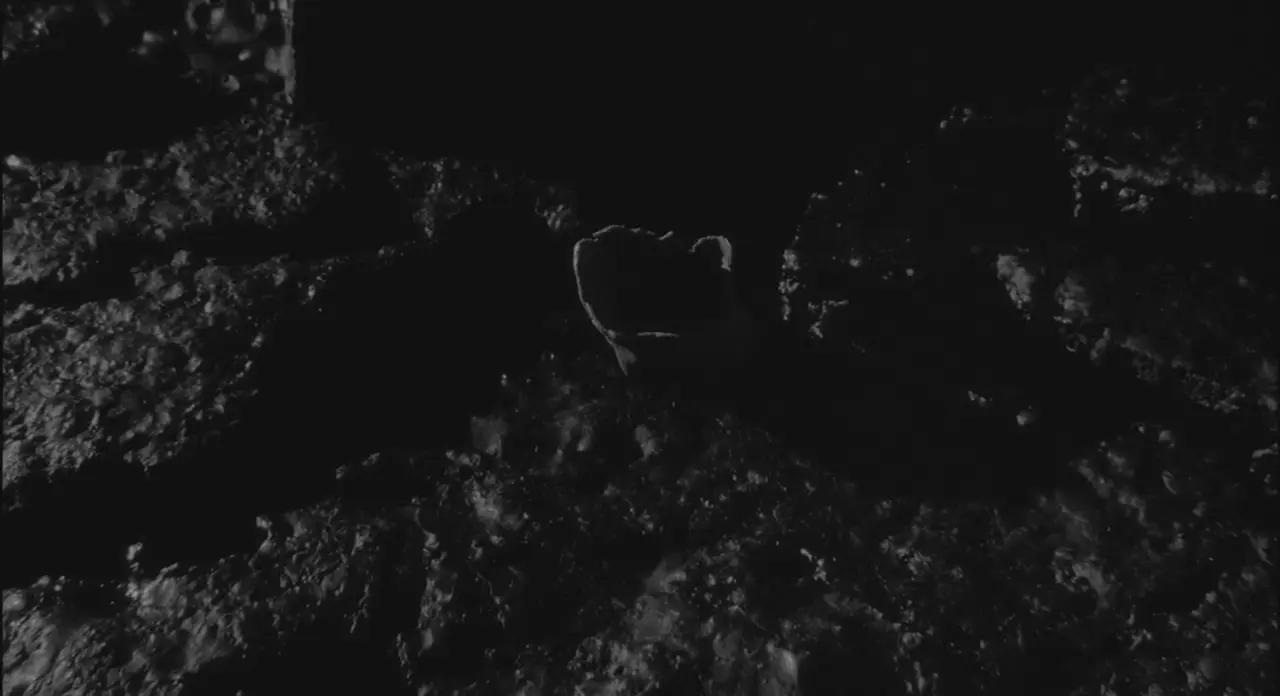
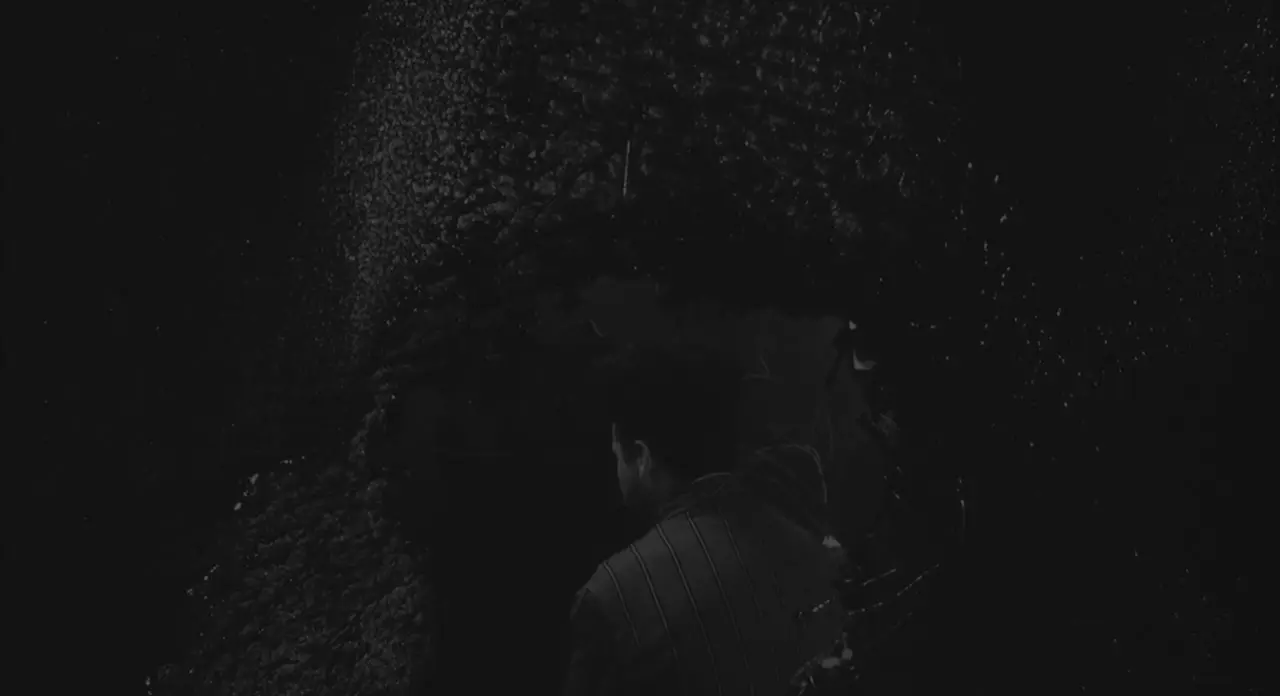
Henry fraying at his PJ pants - like pulling at connective threads; yet still in confusion, until there is a knock at the door at what seems to be an ungodly hour. Unbeknownst to Henry, it is another chance towards personal transformation. However, in all likelihood, he is still in a dream state!
Into deeper waters, and a change of faces
Beautiful Girl Across the Hall is representative of his projected anima, as the seductress or mistress. The reflective image of the feminine or anima has now changed from Mary, the Virginal or Saint, to the Dark Feminine or prostitute, as defined in the Madonna-whore/mistress complex, a split, oppositional anima.
While we have seen glimpses of her throughout the film, she instills a slight but impactful sensual impression on the viewer. It is her imposition on him at the dead of night where her presence takes full capacity. My sense that since there is now only a desirous inclination towards him; at a pivotal moment - where before there was none, further implies that this is a symbolic dance and reparation of the ego that loses Mary again – more on this later. We are moving through continual dream imagery, and Henry’s visible confusion adds to the mystery of the viewer’s conception of reality.
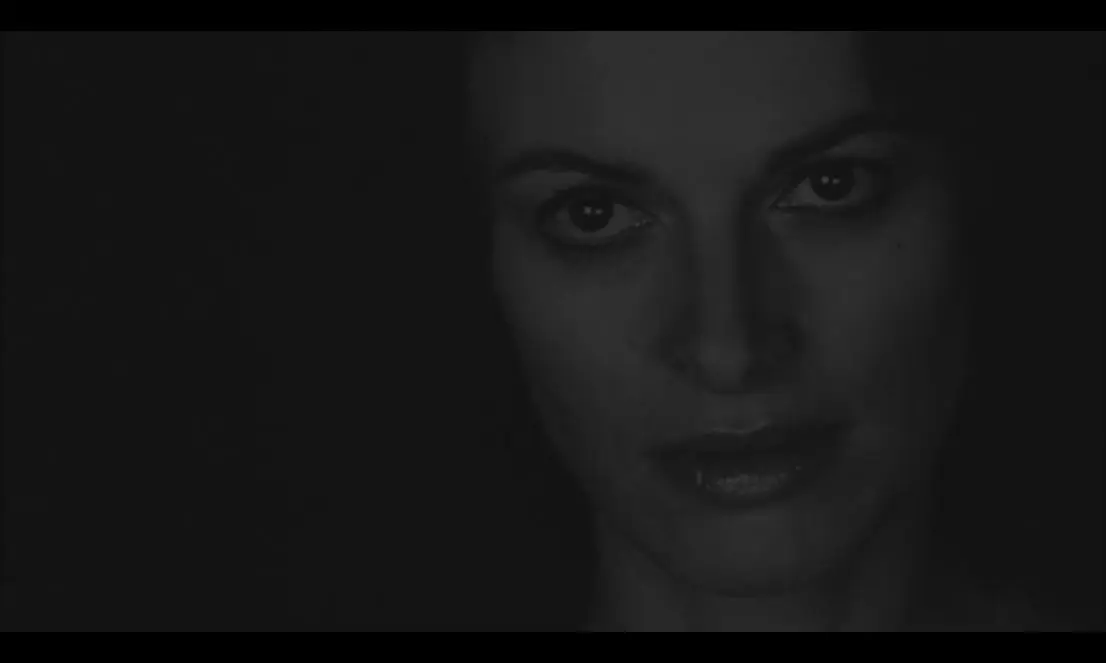
She emerges from the darkness of the hallway and makes her way into Henry’s apartment. Henry, totally dumbfounded, stifles the cries of Spike. Henry, in response to where Mary’s whereabouts are: “Gone back to her parents... Again”. This response implies Henry believes his latest dream was real and thinks he has woken up from it. Eventually, Beautiful Girl’s seduction leads Henry into bed. The light murmurs of Spike catch and perplex Beautiful Girl briefly; however, the unusual sight does not deter her.
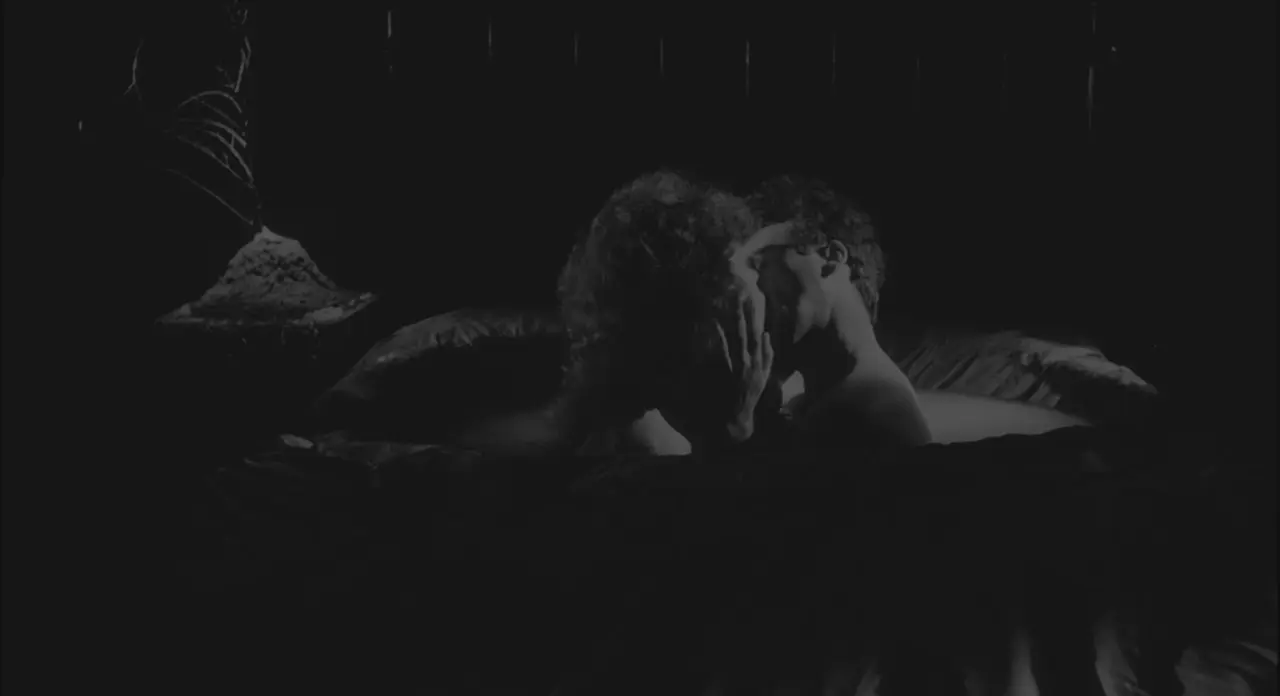
They descend into primordial bath waters (solutio) - a motif of renewal, regeneration, or rebirth. A dissolving preparatory stage, to be put back together again, reshaped, reformed.
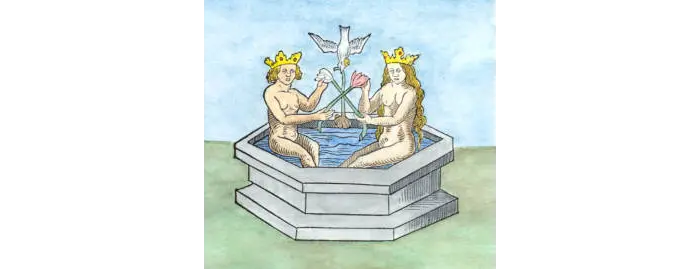
Undoubtedly, this surreal depiction of their sexual union necessitates a symbolic reading. The juxtaposition of the twig mound by the bedside also indicates that Henry now enters the domain of the feminine, the mother’s womb, the unconscious - which aligns perfectly with the cryptic images to come.
In the darkness, Beautiful Girl is faced with the moon rock that is within Henry. Distraught and slightly afraid of its force or energy, she quickly steps back into the shadows.
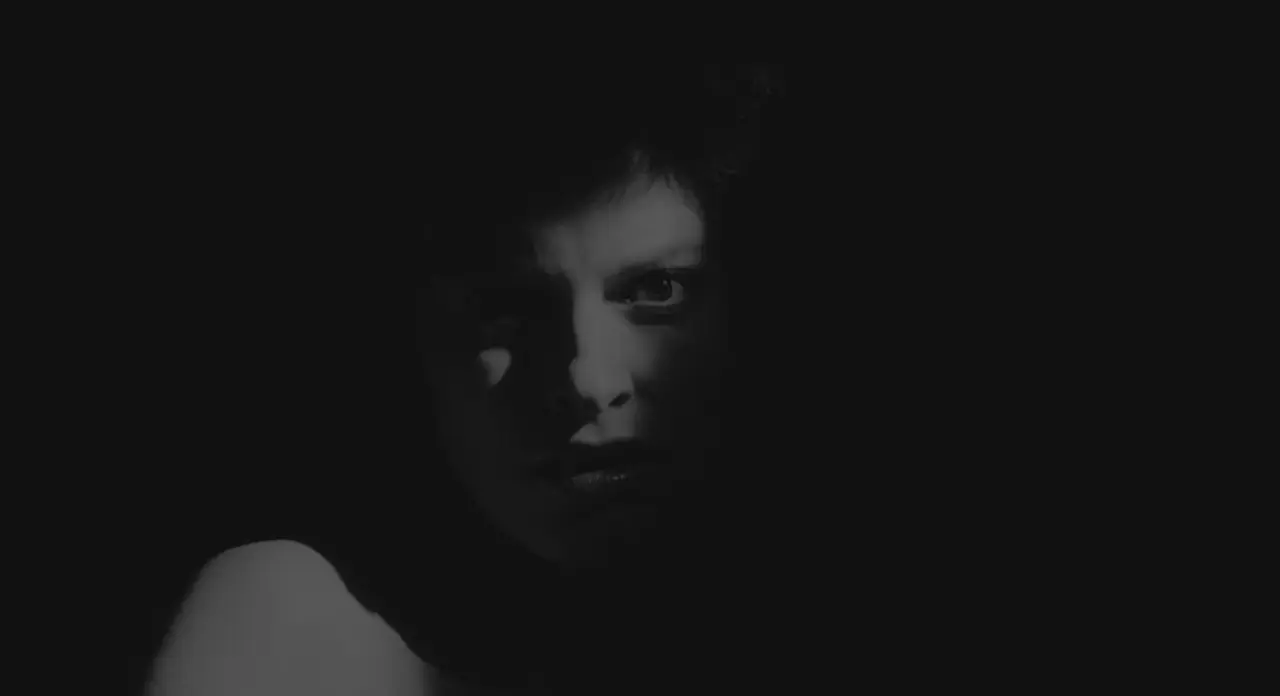
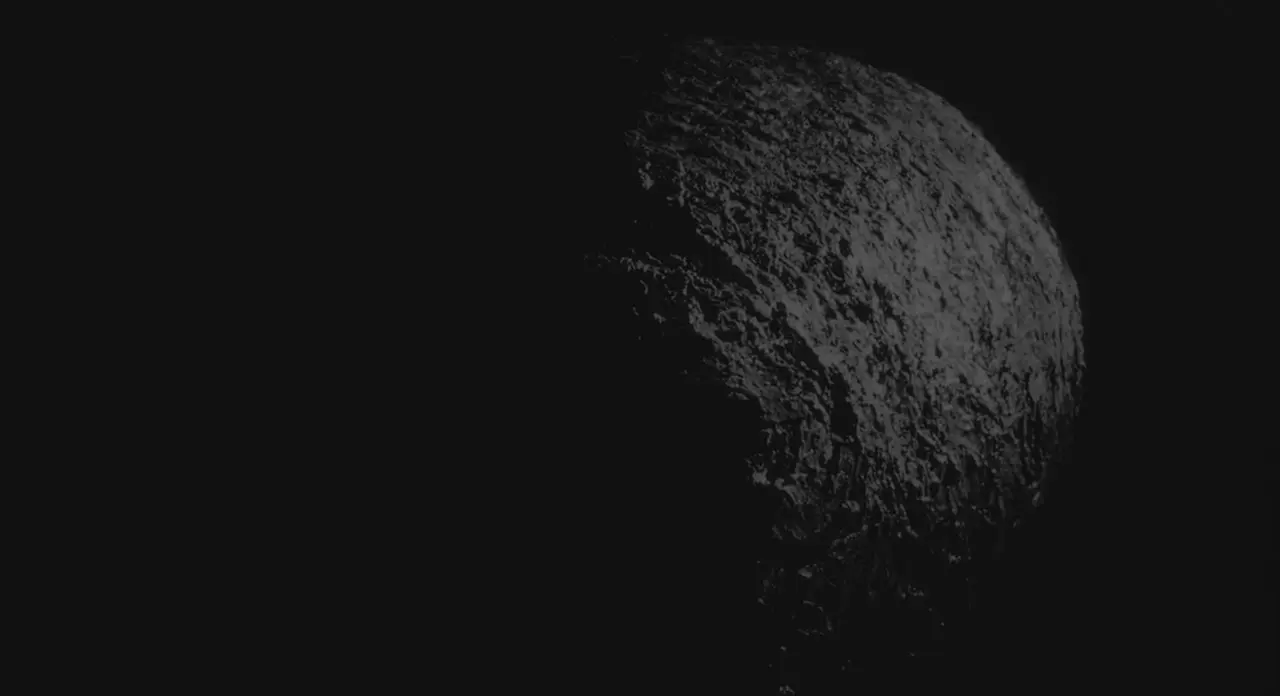
Multifaceted feminine, all parts make a whole
Immediately after, Lady appears back on stage for a beautiful serenade - backed with pipe organs:
In heaven, everything is fine, in heaven, everything is fine, in heaven, everything is fine... you've got your good things and I've got mine
In heaven, everything is fine, in heaven, everything is fine, in heaven, everything is fine... you've got your good things and you've got mine
In heaven, everything is fine.
A reference to the inner reunion (coniunctio), for the male, the good of the masculine and feminine (anima) together, creates an ideal mode of being; a wholeness, heaven. Lady is expressly stating that her good traits are given and enmeshed with his purely. This idea of religious similitude is further hinted at through the choice of music, and at the point of Henry touching her in the following scene, we hear something akin to a liturgical choir in addition to pipe organs.
The appearance of Lady following the seduction by Beautiful Girl (the mistress) shows the many faces the anima can constellate for a man; however, Lady’s depiction is an archetypal image, whereas Mary and Beautiful Girl are complexes of the anima, one as saintly, the other as mistress, this oppositional divide is referred as split anima as earlier noted. Mary left him as she could not be with the monstrous aspect (Spike), and Beautiful Girl picked up the pieces of desire and also facilitated the solutio for renewal of the ego.
We now come to Lady, she is the otherworldly, numinous anima, who encapsulates all feminine parts for the wholeness of Henry when in relationship to his ego consciousness.
With all that in mind, Henry, with a newfound creative energy or libido accessible through the rejuvenation of the bath waters, can appear by the theatre stage to meet her officially. It is more than likely that he is in a dream state.
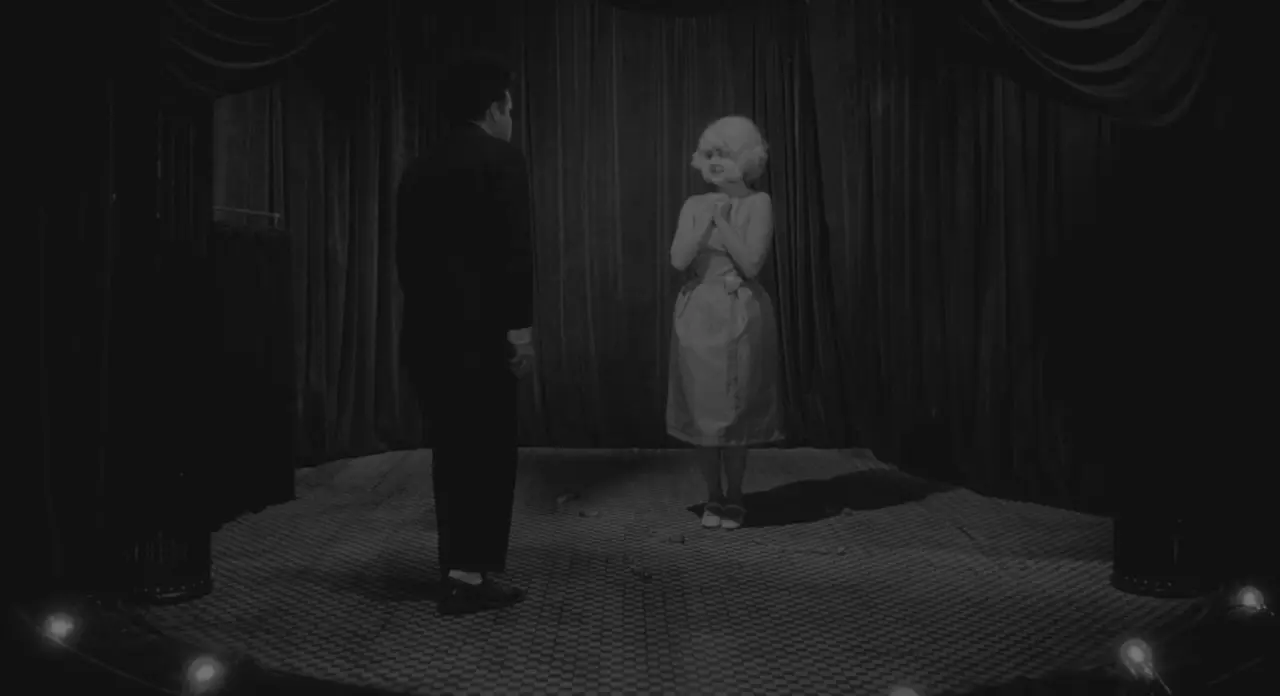
Heaven burns with radiant light
The meeting takes place: he, in disbelief and confusion and she, with anticipation; offers her hands to him, expecting a return in kind. He reaches for her hands, and in doing so, a striking white light fills the screen.
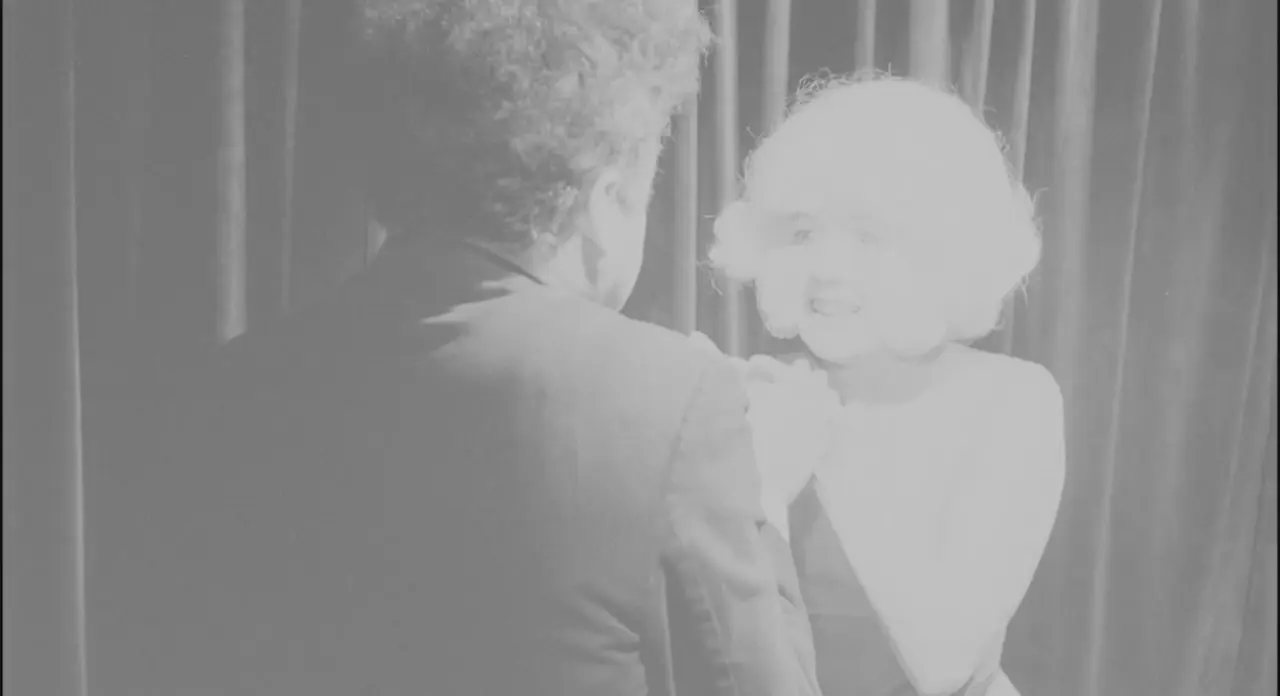
He tries again, but the same occurs; it is now evident he is not ready for such a radioactive communion. This interaction is like a nuclear blast aesthetically and psychologically – just as Icarus, he has flown too close to the sun.
Henry, pained to see her disappear, steps back in defeat, and in her place is a glimpse of Man in the Planet. In a brief moment, as self, displays an aspect of Henry that is confident and assured; he stands in anticipation of what’s to unfold for Henry, and clears the old (sperm critters) to make room for the new.
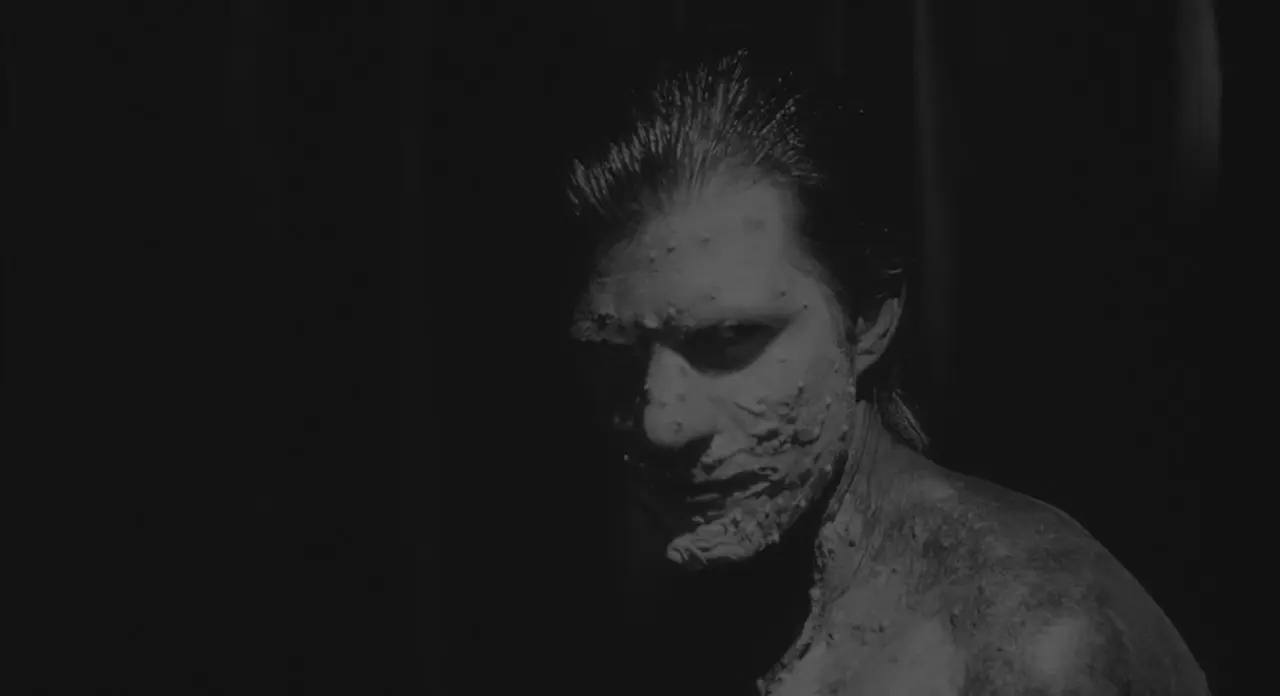
A storm cloud’s silver lining
Henry now completely frightened by the strange atmosphere and sounds, takes a defensive position. Feeling exposed to the entry of a barren tree; reminiscent of the one by his bedside, takes centre stage. Henry now awaits unknowingly his execution and rebirth, by and through her.
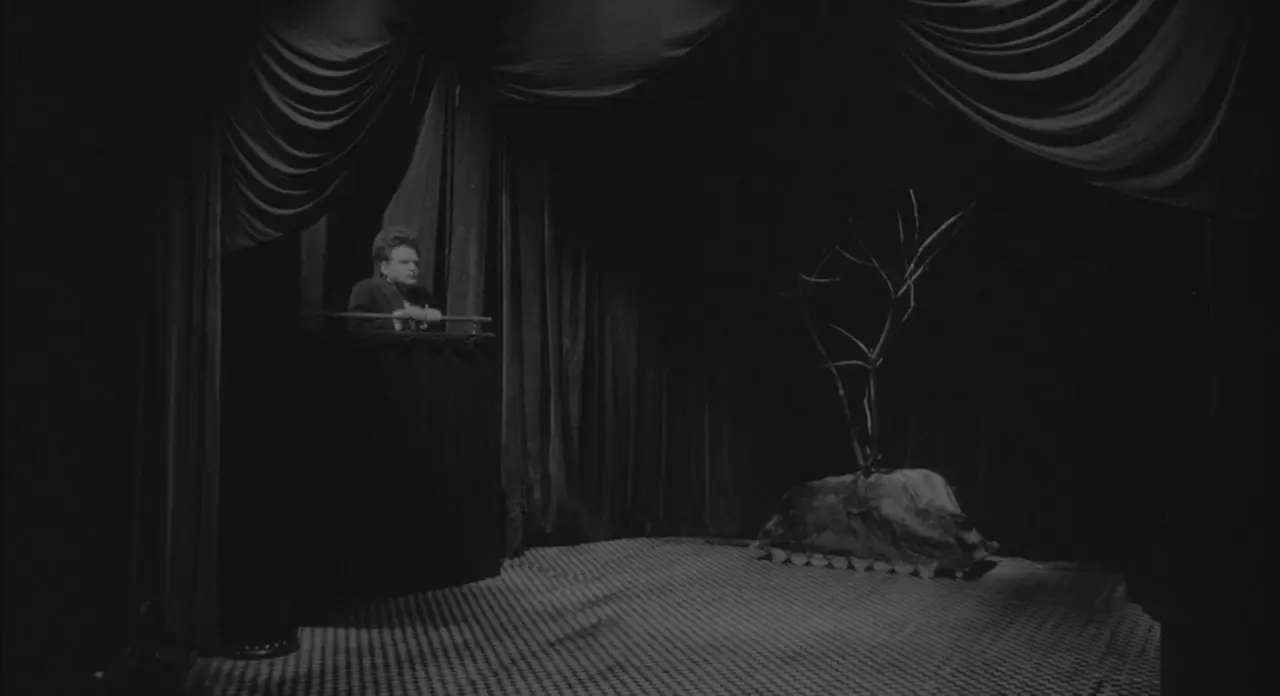
Nervously spinning the handrail, his head pops off; he has undergone a dismemberment or decapitation, which represents an initiation rite. All this will be explored further momentarily.
What follows in the scene is of major importance and relief; as now, although rightly with anguish; there is an emergence of a crying and then shrieking Spike head - labouring anew on Henry’s body.
The scenes that ensue depict a shedding of blood, further signifying this rebirth process, as the new head takes shape on Henry’s body.

Let’s now dive into the symbol of the barren tree atop a mound. Not only was it well-lit for the solutio sex scene, but now in its larger version, the branches are shaped like vesica piscis (vulva, in this case). From this reproductive symbol, we can extrapolate her role in the film, as an approximation of The Great and Terrible Mother (or Death Mother) archetype, since she encompasses the power to create and destroy. Here she decapitates and begins the rebirth of Henry’s new mode of being.
The typical Great Mother archetype symbolises birth, creation, healing, etc. (Virgin Mary, Isis) and the other destructive, chaotic, judgement side could be seen as the Terrible Mother. However, it is a necessary agent of renewal or redemption through strife (like the cross of crucifixion, or like the Unnamed Arcana XIII (Death card) in Tarot. There are a number of deities that encompass polar energies or dual natures in general, but specific to creation and destruction, we can look to the likes of Kali Ma.
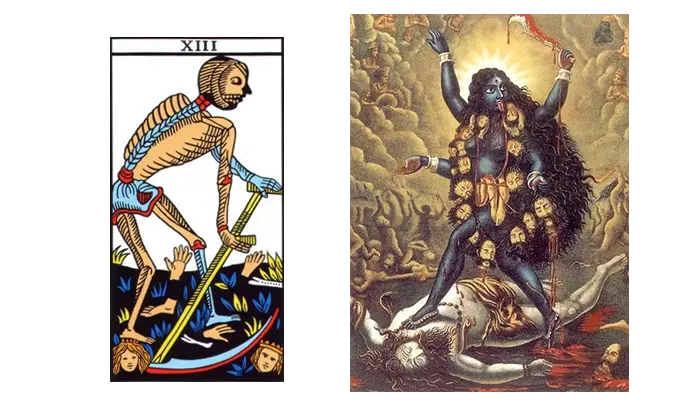
The Great and Terrible Mother represents the womb to seed life and the cross of execution or dismemberment, respectively. Death and (re)birth come from this archetype.
Let’s continue with the film - the blood now flows towards Henry’s lonesome head on the stage, which then sinks into the puddle on the floor. The scene switches to a sky as the head is in rapid descent and lands smack onto the pavement, surrounded by industrial fare; his powerful dismemberment in progress.
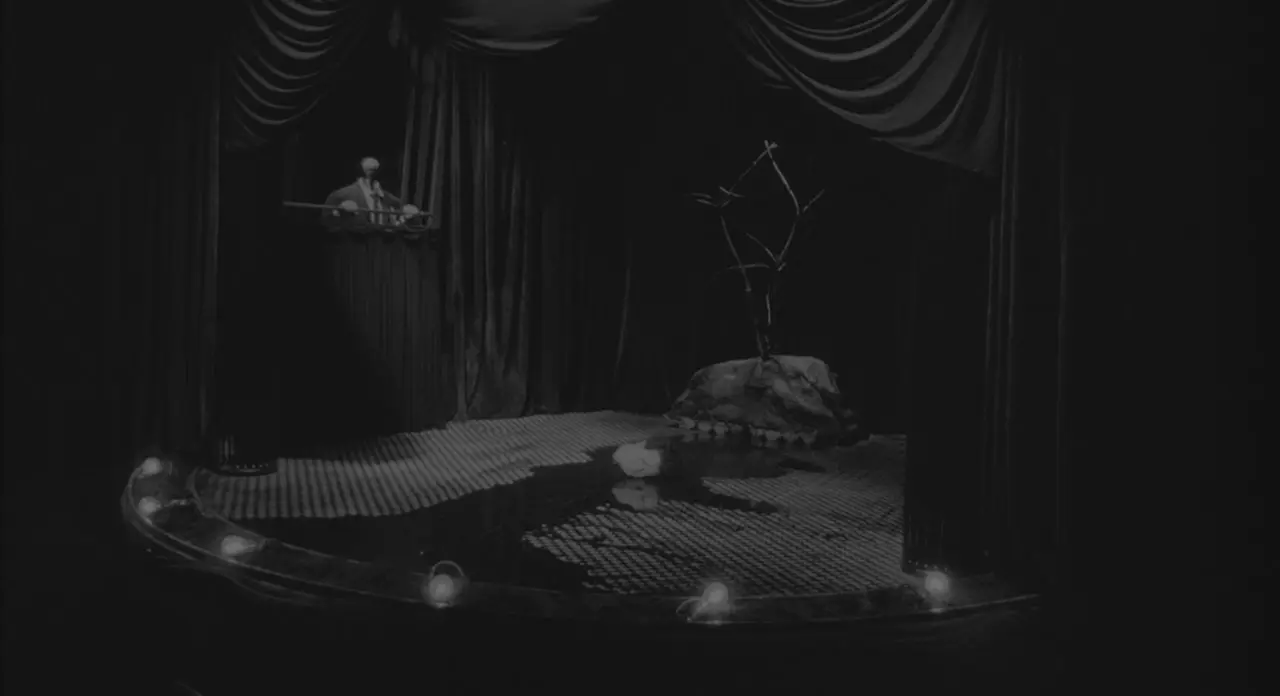
Where’s your head at?
We will shortly arrive at the infamous pencil factory segment; here is truly the crux of the film. The importance of this array of imagery cannot be undermined. On the macro level, a large claim that will be explored is that it is also the origin of Lynch’s creative essence – the reason why we have a coined term like ‘Lynchian’ (David Foster Wallace, David Lynch Keeps His Head, 1996).
This is the origin of the creative potential turned master, the weaving source thread that guided and instantiated his unique imprint on the world. One that so affected and inspired countless other creative professionals and audiences alike, and my reason for stating this, as we will get to, is in review of Lynch’s pencil factory saga as being drawn from a personal context; it is his own ‘daydream’, therefore a window into his unconscious workings.
“A man’s head bouncing on the ground, being picked up by a boy and taken to a pencil factory. I don’t know where it came from.” (Greg Olson, David Lynch: Beautiful Dark, 2008)
When dealing with dreams and the unconscious, the images are symbolic and indicate a point in time or reflection as to the dreamer’s life path or journey; the combinations and stories are endless and infinite, and interpretations vary a lot, but there is a collective stream of symbols and archetypes that remain the same across individuals, even across cultures and religions. In Eraserhead, we have a dream-like sequence that we can attempt to decipher that uniquely reflects on the special and elusive nature of the film, a film that had time to gestate (5 years) with long periods of downtime, struggle for funding in between, and a rigorous final edit.
Coming back to where we left off, the screen capture of Henry’s decapitated head. While this is a complicated symbol, demonstrates a process called unio mentalis, it is a simultaneous action that involves the head – or centre of thought, logos, and psyche that undergoes a separation (distractio or more commonly, separatio) from the body to overcome its primal drives. What is left is essentially soul and spirit, which now form a union against the body, to recalibrate the essence of the ego, in such a way that could be likened to a mutiny.
The unio mentalis brought by decapitation, invokes a “spiritual-psychic counter-position—conscious and rational insight” (Edward Edinger, The Mysterium Lectures, p.286) without the ‘trammels of nature’ (Jung, Mysterium Coniunctionis, par 730), i.e., physical or sexual desires and “freed from its fetters in the things of sense”. (ibid., par 696) The purpose of this achievement is “in order to bring anomalous psychic states of an affective nature, i.e., neurotic symptoms, under the control of consciousness... a rational, spiritual-psychic position over against the turbulence of the emotions.” (ibid., par 696)
Henry’s predicament is an extension of Lynch’s inner alchemy. Henry’s head undergoes a reordering of psychic attitude in the unconscious. It is not too much of a stretch that Lynch had his own recalibration, since this is his dream. The beheading or dismemberment motif is indicative of an initiatory shamanic-like path reserved for the few (Cf.. Eliade, Shamanism, pp. 53ff). Lynch led an elusively muse-guided love of art and the craft, and remained authentic to that drive and desire from the beginning (although a lesson was reinstated with the making of Dune). This endeavour came at great cost to him, just as the film dictates with the unravelling turmoil and showdown with Spike.
Inner child saviour facilitates a second chance
Henry’s head lay for a brief moment there on the pavement, with his scalp off and brain exposed. A boy races to grab the head from the ground, while an old man observes and strains to reach out his hand long after the boy has gone. The man appears to be homeless and at the end of his life.
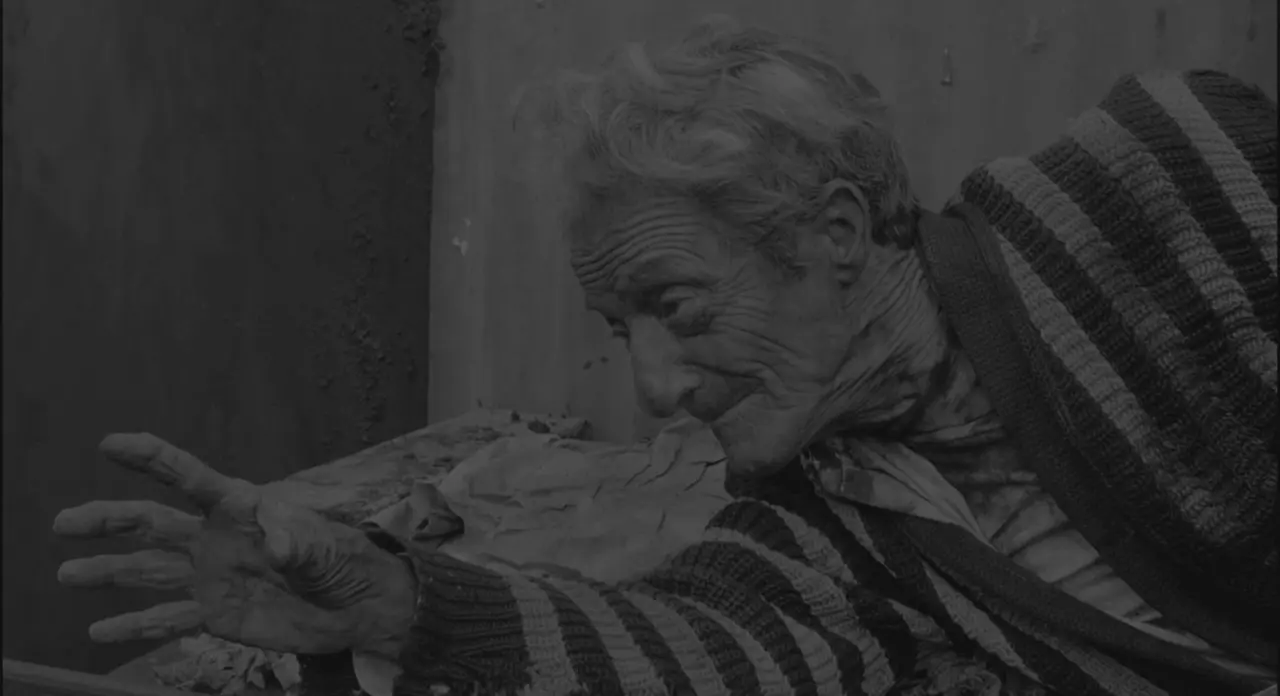
This realm, which resembles somewhere real as opposed to the theatre stage, is still operating in the dream space or unconscious. It is representative wholly of the spirit or masculine aspects within Henry’s psyche that each has their own personality and character. The boy who races forth to hold Henry’s head and take it somewhere so it can be fixed - is a life force or inner child within Henry that seeks renewal, change, or a drive to keep going.
The old man (senex or wise old man) is an aspect of the archetype of the Great Father. He presents here as weak and almost seems like he wants to reach out to help, but it’s not his place to any more, and it is up to the child (puer aeternus “eternal boy”) to bring forth the new.
“The infirm and weak old man represents a conscious dominant or spiritual principle that has lost its effectiveness.” (Edward Edinger, Anatomy of the Psyche, p. 167)
This conscious or spiritual mode is a representation of an important pairing (syzygy) of archetypes: boy and old man (puer and senex).
“Graybeard and boy belong together. The pair of them play a considerable role in alchemy as symbols of Mercurius.” (Jung, The Archetypes and the Collective Unconscious, par 396)(Mercurius here means aspects of the unconscious)
The nature of this pairing is cyclical and self-renewing between the growth, death, and rebirth of the archetype. They each represent aspects of the spirit that have both positive and negative qualities in opposition, yet in support or succession.

The boy takes the head to the factory, where a man at the desk observes the dire situation and buzzes his boss incessantly. It’s like ‘Code Red’, this is serious and needs attention.
The boss is not too happy to be called in such a manner, but is joyous that the boy has brought the head. He knows immediately to take him to the inner room. The pencil maker is unfazed by the head; there is a sense of normality to this situation, even if the others were not privy to such an experience, but are acting on instinct. He prepares a drill to insert into Henry’s head to retrieve a cylinder shape, that is then slotted into the machine; which produces a pencil to be tested on paper.
This scene has always felt like a complete mystery. Why is there a pencil factory in the middle of this film?! Let’s try to unpack this.

Erase the head
The pencil factory is like going into the inner workings of Henry’s psyche after the initiation of beheading - as has been commented already. My sense of this scene is like having all hands on deck to resolve his system shock. However, the overall process that takes place next is similar to Anubis weighing the heart of one’s soul against a feather.
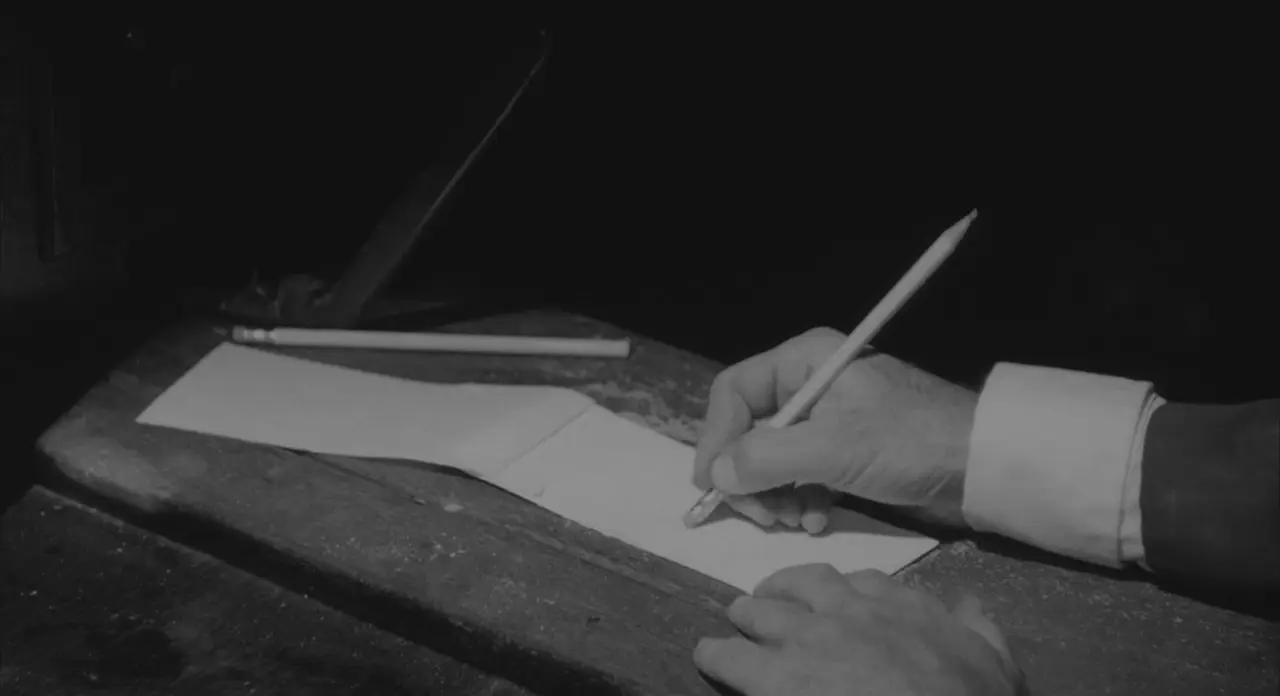
Henry’s pencil quality or lead is checked on paper, a recalibration takes place via the soul and spirit union (the unio mentalis). It passes the test and has the chance to undergo development consciously. An opportunity lies now in Henry’s conscious reality to transmute his situation, with an aspect that can come forth that did not exist prior.
What has quite literally happened in Eraserhead is that our dear Henry has his head erased! Through the dissolving waters of the anima mistress, the anticipation of the self to the initiation process, the beheading by the Terrible Mother, and the beginnings of a rebirth through her, which ultimately leads to a total reworking of the spiritual and conscious attitude to activate a sacred mystical path. This factory scene is a test of the head (the lead within the pencil) and the eraser, both north and south, working in unison.
Lead (prima materia) is representative of the unconscious’s unrefined aspect of self and is also tied to Saturn, both providing strong links to one’s shadow aspect, in need of purification or transformation. Henry’s lead or saturnine spirit is purified by the eraser, and by extension, so is Lynch. Here, as director, in one of his most cryptic sequences, demonstrates his successful completion and acceptance of the beheading initiation - into a confirmed shaman.
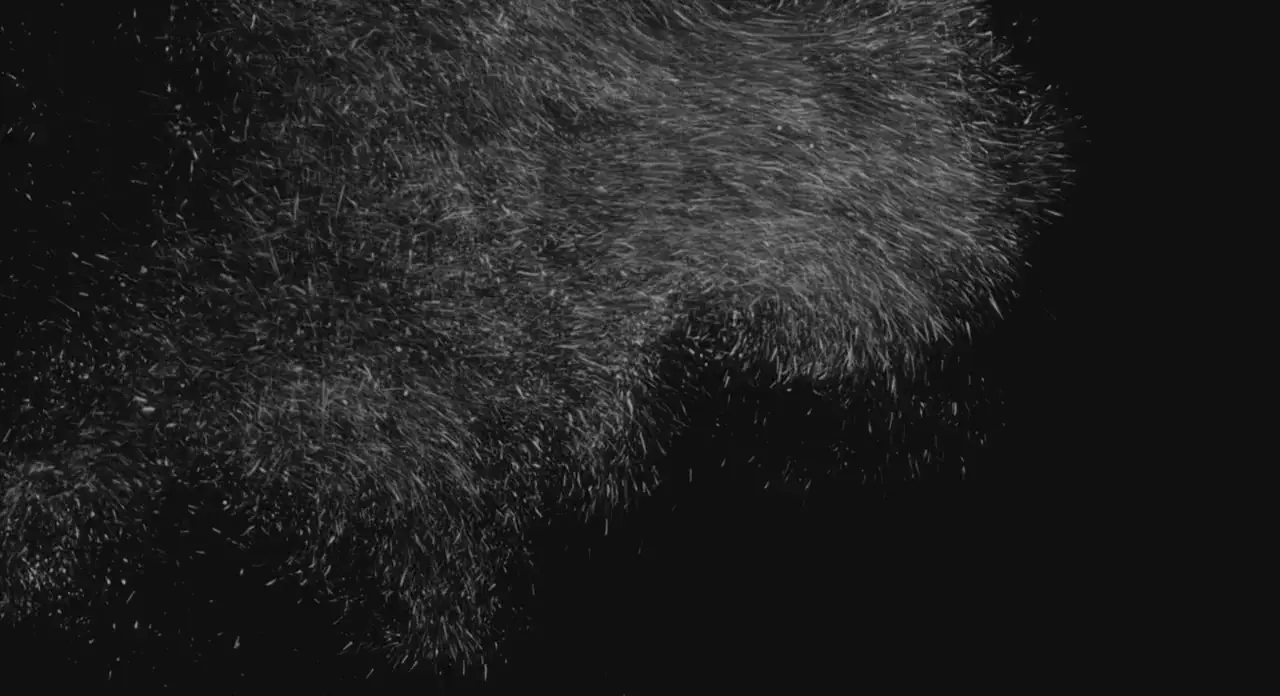
Window as mirror
The window we usually see has an awful view of the bricks of the building next door, a bit like a bad joke than anything. It cements the overtone of his world, isolating and dreary, lacking perspective and vision.
Henry, upon waking from this wild collection of dreams; a little bit anxious and confused, peers out the window, where he catches sight of a man beating down another. An interplay within Henry, the outer and inner worlds meet to reflect his state, in synchronistic fashion.
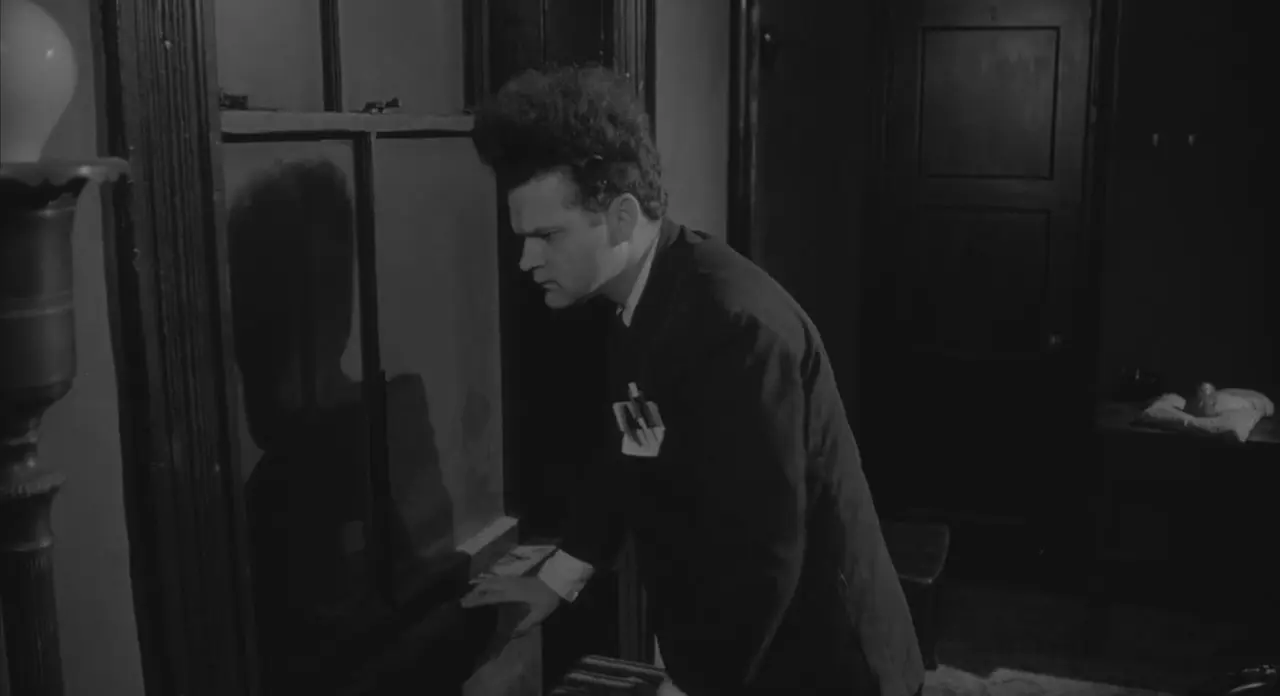
Hearing various taps and knocks in the apartment, Henry thinks Beautiful Girl might be back home or nearby, so he goes to check on her, but she is not there or does not answer. Henry is now left with himself without distraction. Spike has always been a counterpart of Henry, yet now it reacts quite suddenly and negatively - adding insult to injury, in what can only be described as snide laughing.
Henry, taken aback, notices this creature may not have his best interest at heart. It laughs again while Henry is back with his thoughts on his bed, and quite aptly, the fraying of his blanket (mind) continues, as do the random sounds of the residents in the building - ever torturous. He unravels the events and stews in his thoughts, feeling as though he has lost a grip on reality.
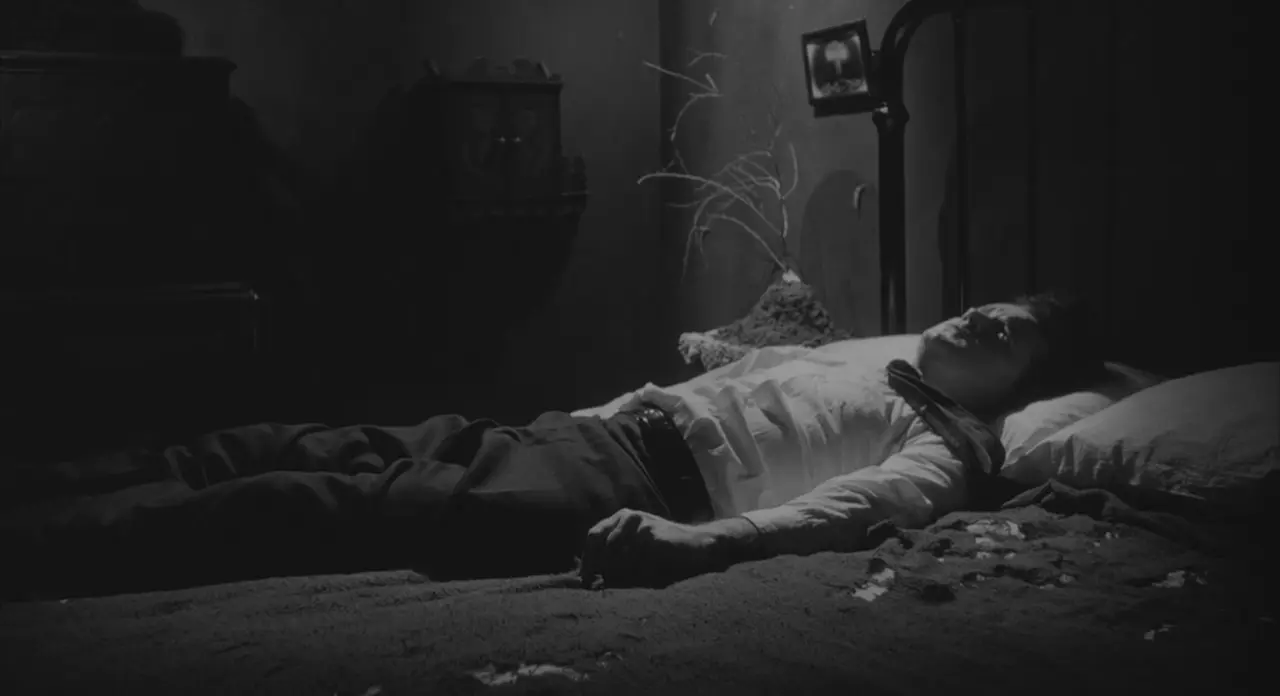
Hallway exposé
Upon hearing the elevator door, he jumps out of bed, where the culmination of all anxiety and mental discord is met with Beautiful Girl - now with another man across the hall and ready to enter her apartment with him.

There is an exchange of glances, the man hardly able to keep his hands off her. Beautiful Girl feels not so much caught, but later uncomfortable that Henry lingers and is watching the display.
What takes place just before the close-up is a gaze, like being seen, not that she has been caught cheating on Henry (since their liaison was symbolic and in Henry’s unconscious), but as the feeling of being exposed as a lady of the night.
A dream recall is the moment when an image can enter your awareness that links to a dream fragment, allowing you to recall more of the dream and the pertinent symbolism. With this in mind, the following close-up scene and change of demeanour could be viewed as a dream recall from Henry’s perspective. Beautiful Girl, as the projected anima, instead of facing down the cosmic rock, is now witness to the aspect that is in the process of transformation. The sound design of this scene and the intimacy of the interaction connect solidly to the dream sequence in question.
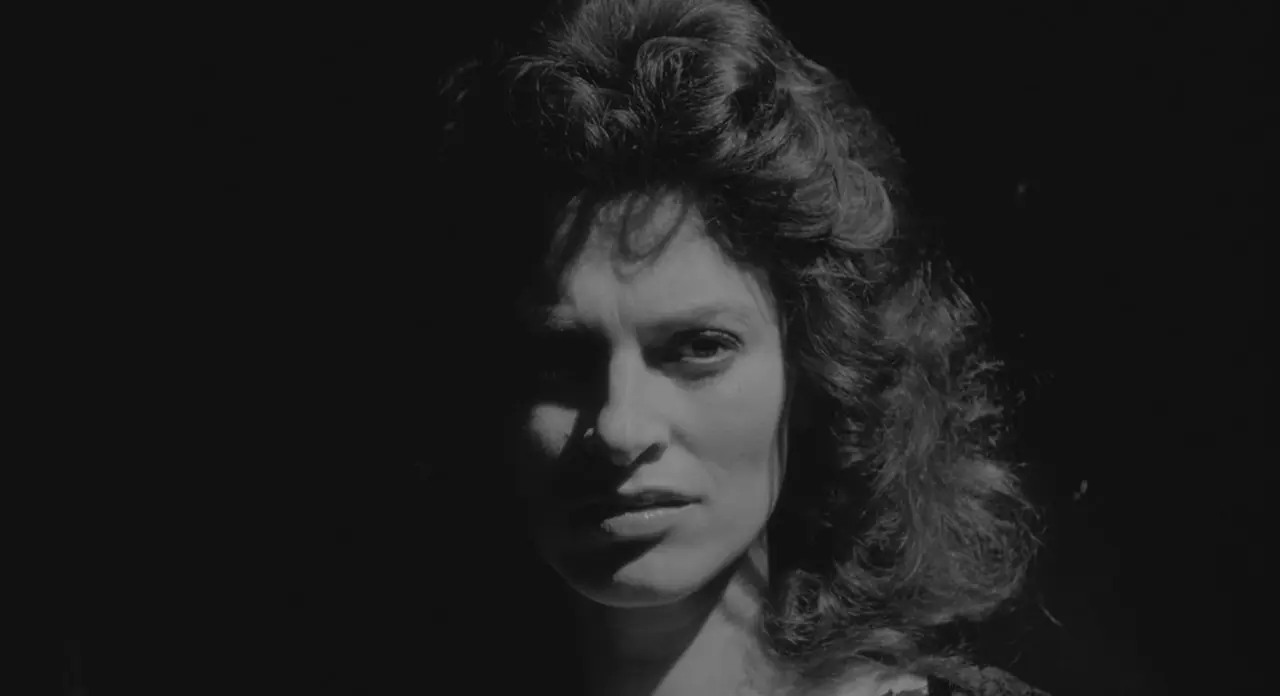
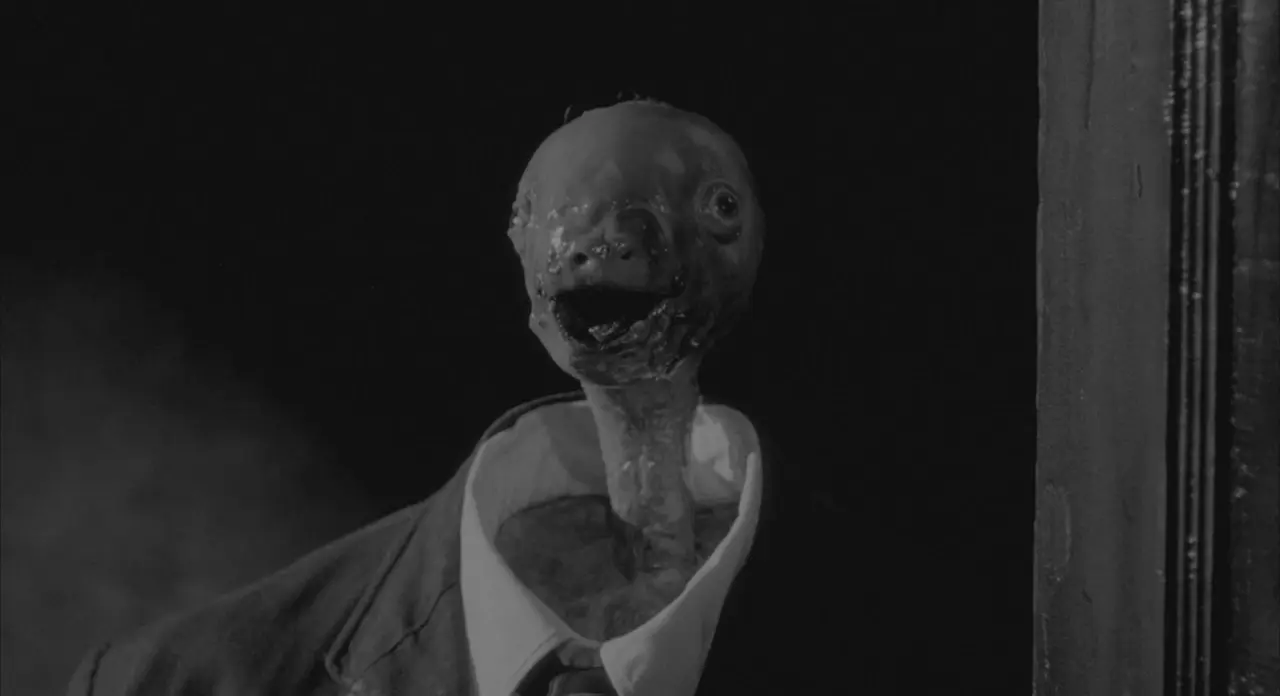
The first encounter by Beautiful Girl with the cosmic rock evoked fear; the interaction has now transformed into a level of openness, with subtle inquiry. Henry is now depicted as the newly born infantile head, as seen in the dismemberment sequence. A new conscious attitude of Henry has emerged, but cannot fully take shape without a conscious act.
It may appear he is taken aback upon seeing her with another man and unclear on what to do. However, when we parse through the particulars, this real-life interaction is all about Henry, and not at all to do with who Beautiful Girl is or her dalliances, but rather what she symbolises to him. Still, the interaction is pained with embarrassment and shock, left in confusion over the tumultuous events of the night. He quickly shuts the door and spies through the keyhole, but is only left with the sight of her closing door. Frustrated and seated in darkness, he glances from the radiator to Spike, now with a look of contempt. All his disorientation and trouble seem to stem from this creature.
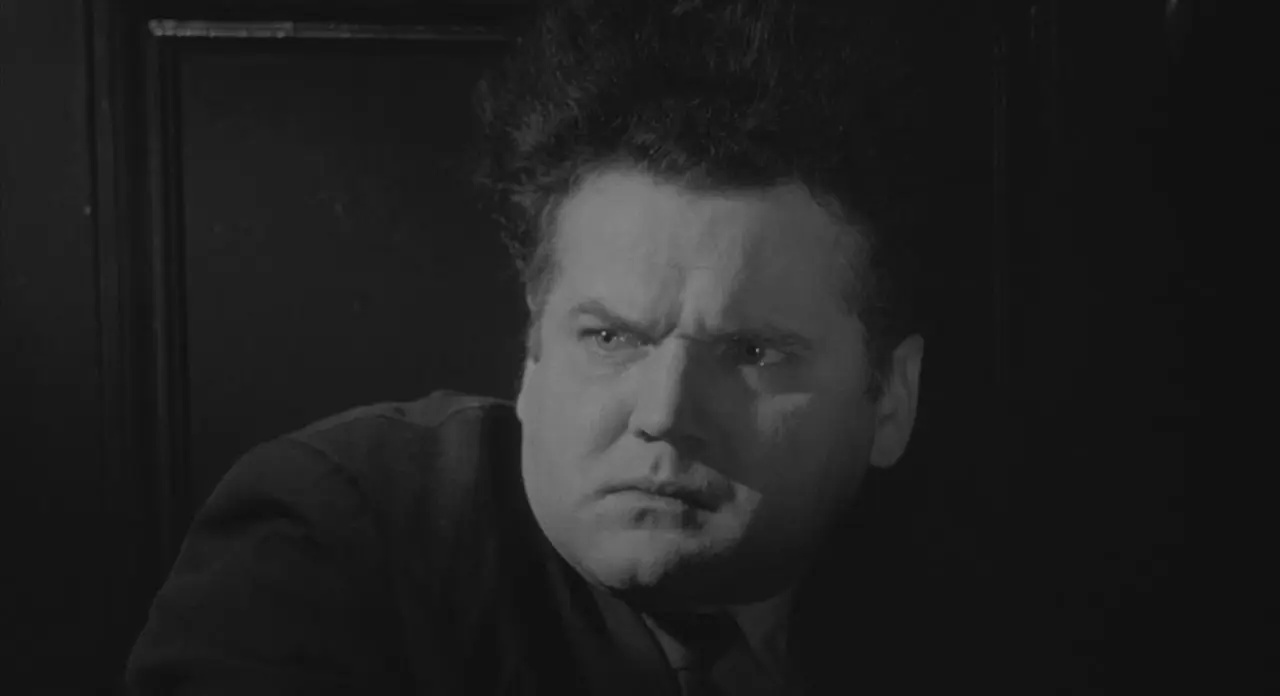
A necessary self-surgery for revelation
At this point in the film there is a sense of care for this creature, despite its alien features - it mimics all the fragility and dependence as expected from a human baby. As the viewer, we have a feeling that Henry is acting upon an insecurity, and it feels unthinkable and ghastly to do what he is about to do. Henry retrieves scissors from his tall dresser and approaches Spike with hesitation. There is a sense of curiosity mixed with a question of capability. It starts to become clear that Henry is on a mission to snuff out the creature as the source of his troubles. Spike begins to snivel in response to the cutting of his bandages. A dissection where we are immediately face to face with the brutal ugliness of its insides. Non-human, animal-like. It is horrific, and even Henry cannot bear to see its grotesqueness.
Its organs slowly expand, and Spike sounds as though he is already in death throes. Henry, with a mix of emotions, stabs the creature in a moment of pointed courage - when an oozing liquid leaks forth from its insides and blood bursts free from Spike’s mouth. If that wasn’t dramatic enough, a fluffy substance protrudes like a foamy avalanche out of Spike’s body. Henry’s floor lamp threatens to go out at this pivotal moment...
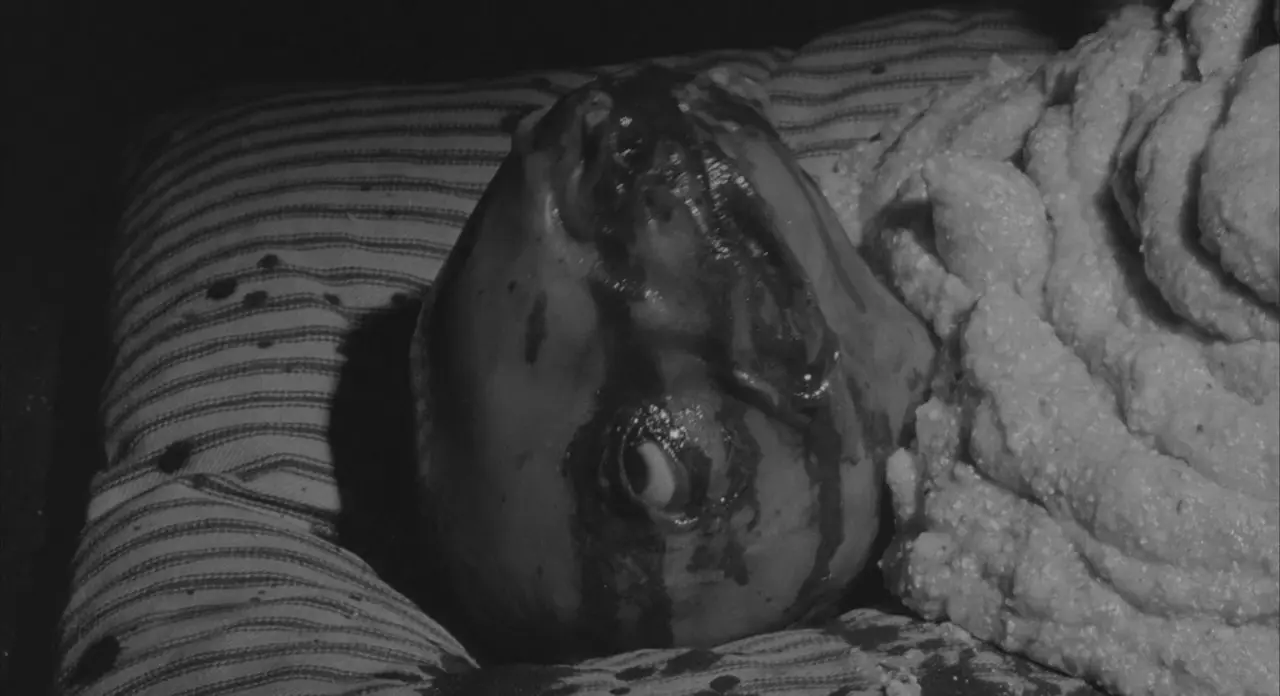
It may be a good time here to break from the intensity and to focus briefly on the element of electricity in some prominent moments throughout the film, and specifically for Henry. He gets a nosebleed when he receives the news of the “baby” in the hospital. Before that showdown scene with Mary's mother, our attention was drawn to lights in the X’s family living room, which appear to buzz gently and go out. Fast-forward, we are once again hit with another flickering of lights, but this time it is more powerful and ultimately short-circuits from the socket panel. It is clear in both these instances, we are witnessing psychic energy; a poking through the veil of conscious reality that is then reflected through light energy – electricity. Henry was unaware the first time it happened, but he is now fully present for this shift in consciousness.
Floating head... flashing lights...
Spike’s head extends and tapers off from the source in one of the most bizarre sights yet. It emancipates itself from the body and comes to life as a sole giant head.
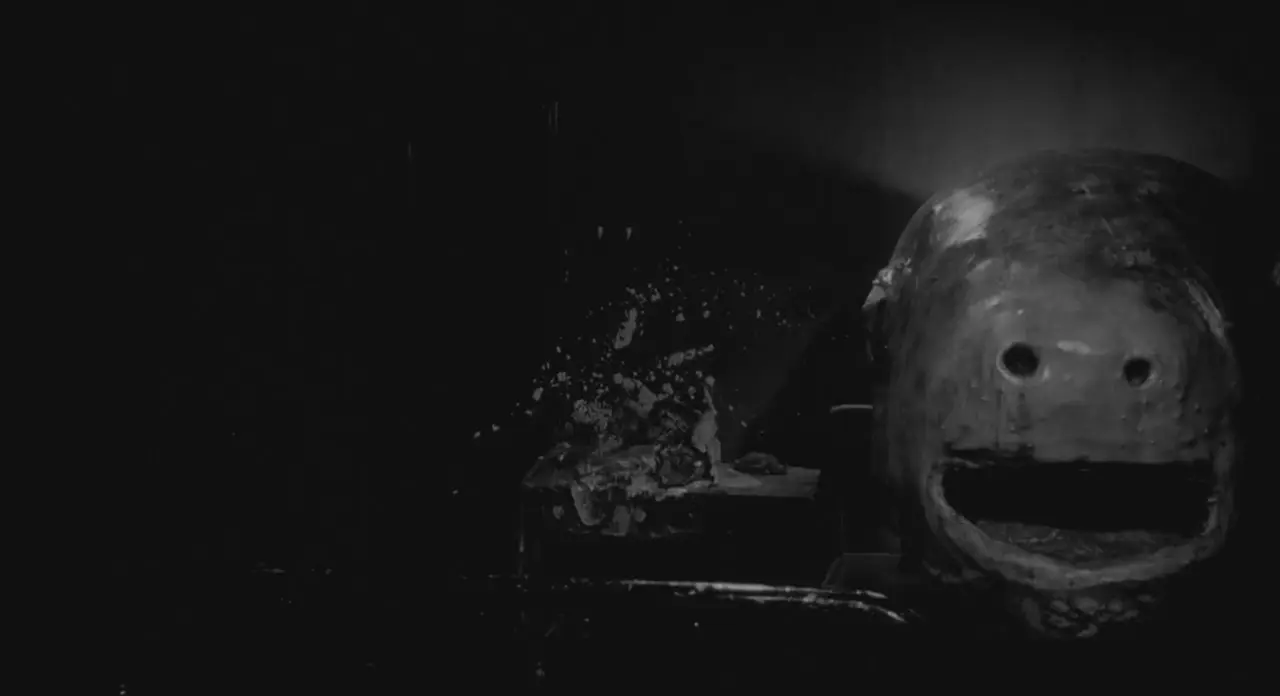
The dismemberment or decapitation motif is present again here, but specific to the symbolic nature of the head entering a divined status, similar to a shaman or oracle.
To elaborate on the point, in the tragic Orphic myth, Orpheus, after failing his conditional rescue of Eurydice from the underworld; is killed. Orpheus’s head floats along the river towards Lesbos, where it becomes an unrivalled oracle - till Apollo seals his fate.
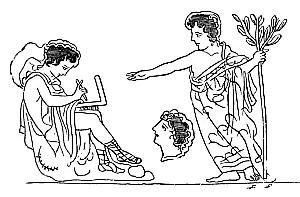
Henry, amidst all of the horror, is backed into a corner, gazing intensely with fear. What has he unleashed? The head parades around the room, hauntingly teasing its approach, when it eventually descends upon Henry, as the lamp light finally goes out.
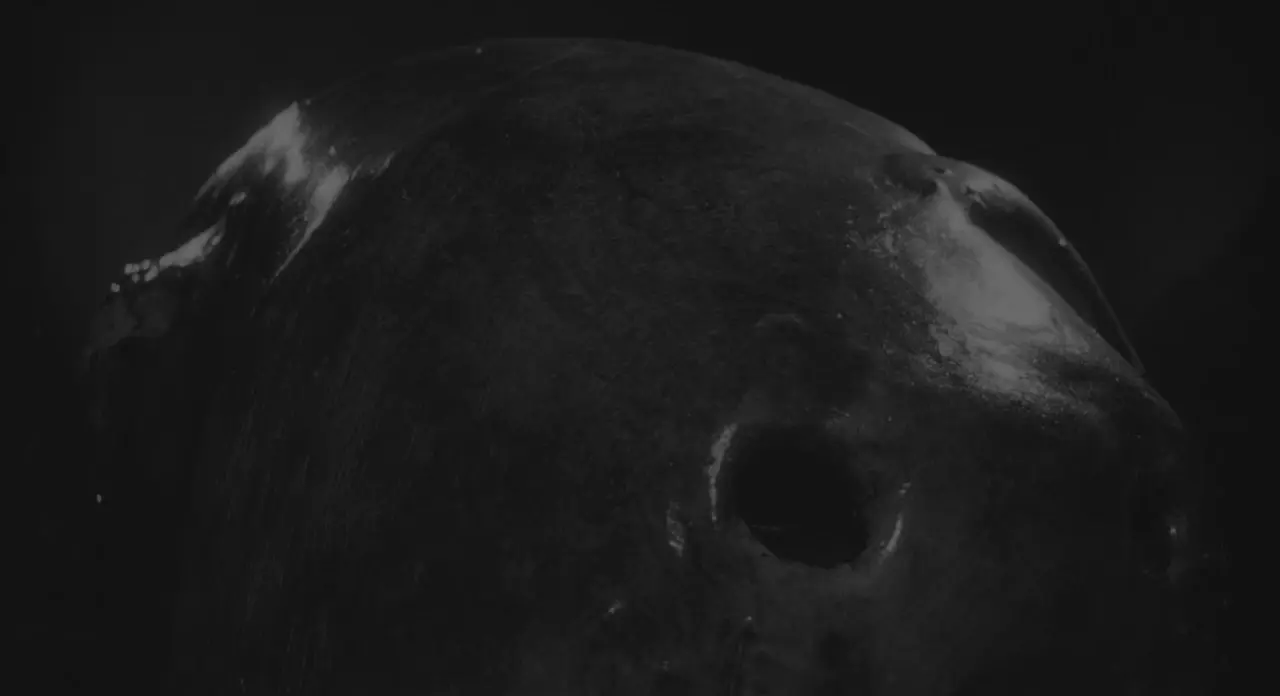
Up close and personal
Shrouded in darkness, both literally and figuratively. Spike has forced a face-to-face confrontation; it is no longer hidden in his unconscious mind, nor is it defenceless; it demands an unavoidable enlarged focal presence. Henry looks away from the creature once more.
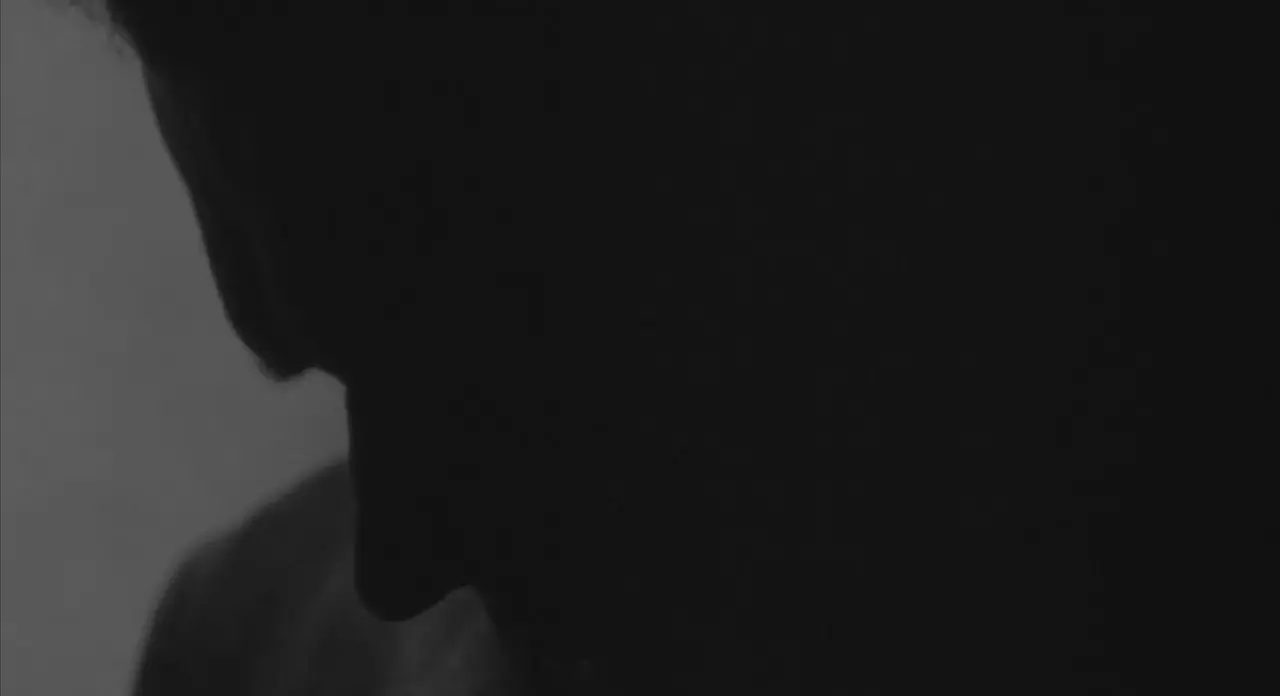
After a noise and light flash, he looks back to see Spike has morphed into the moon rock that we were introduced to in the cosmos at the beginning of the film – in Henry’s unconscious, only now is it being seen through his ego. Henry, with great trepidation, must peer into the darkness, face the abyss, to discover the compartment within - that holds back his development or individuation.
He is now gifted with the awareness of the inner aspect and must face it.
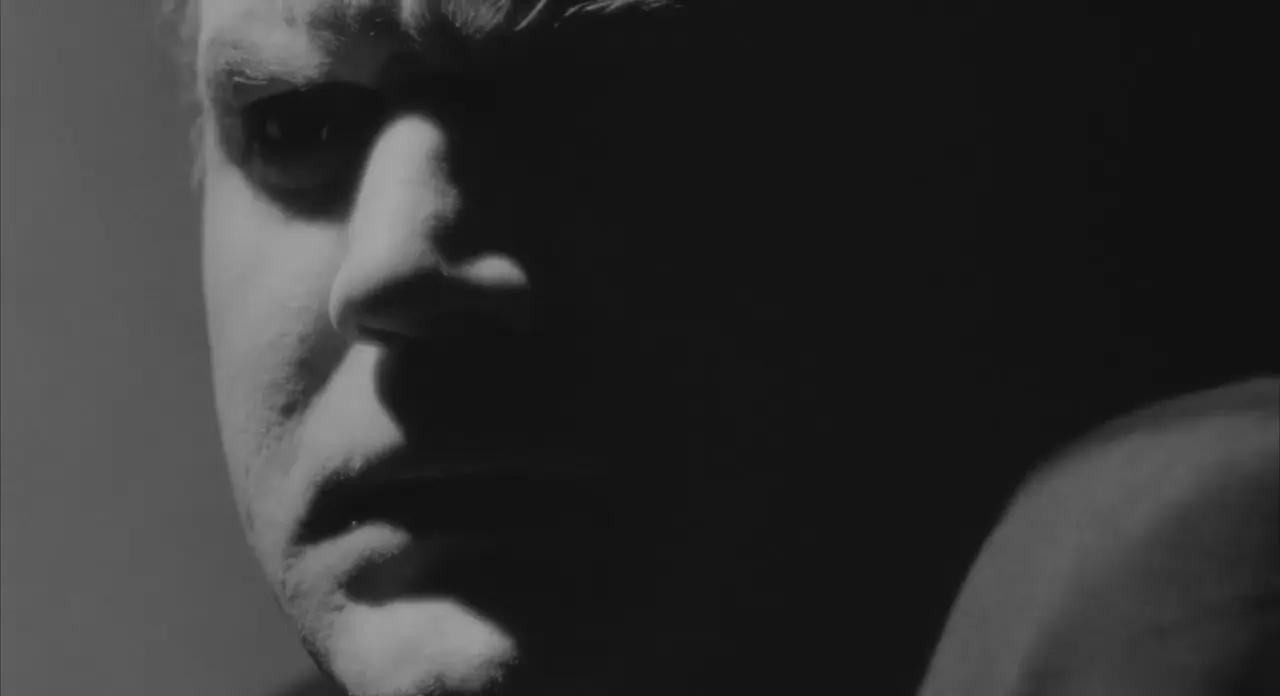
In doing so, the cosmic egg cracks open. Henry is awestruck by the revelation of his inner world.
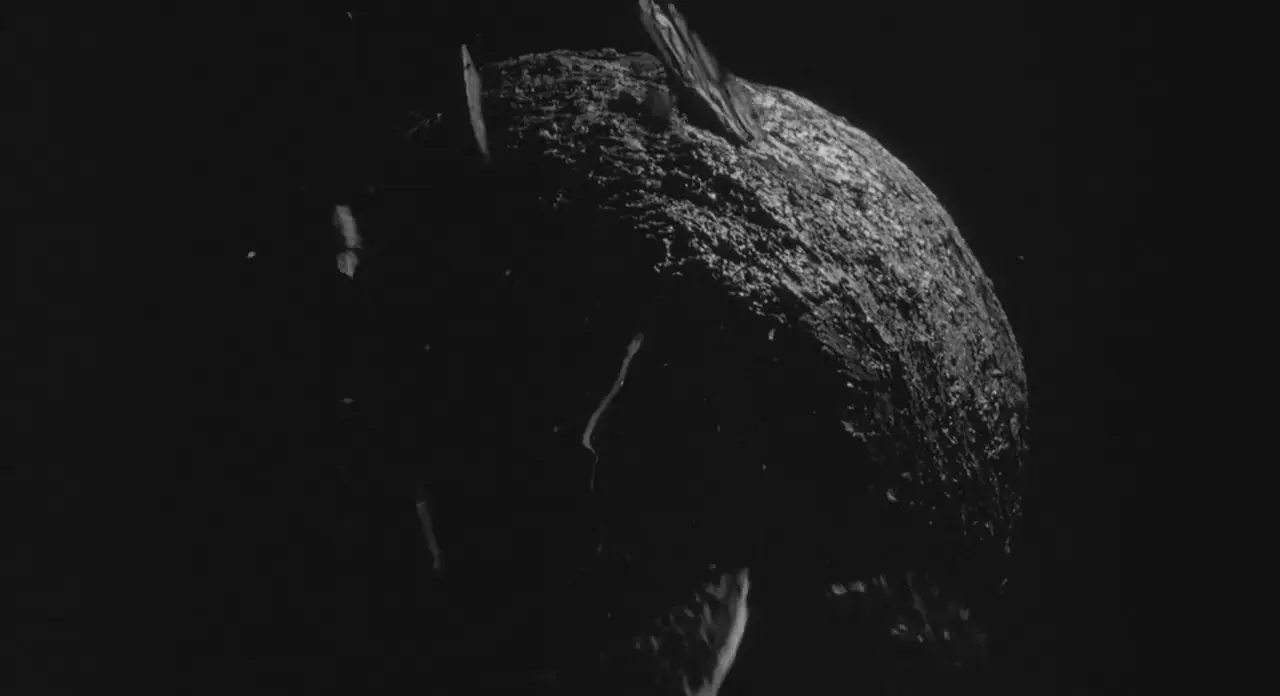
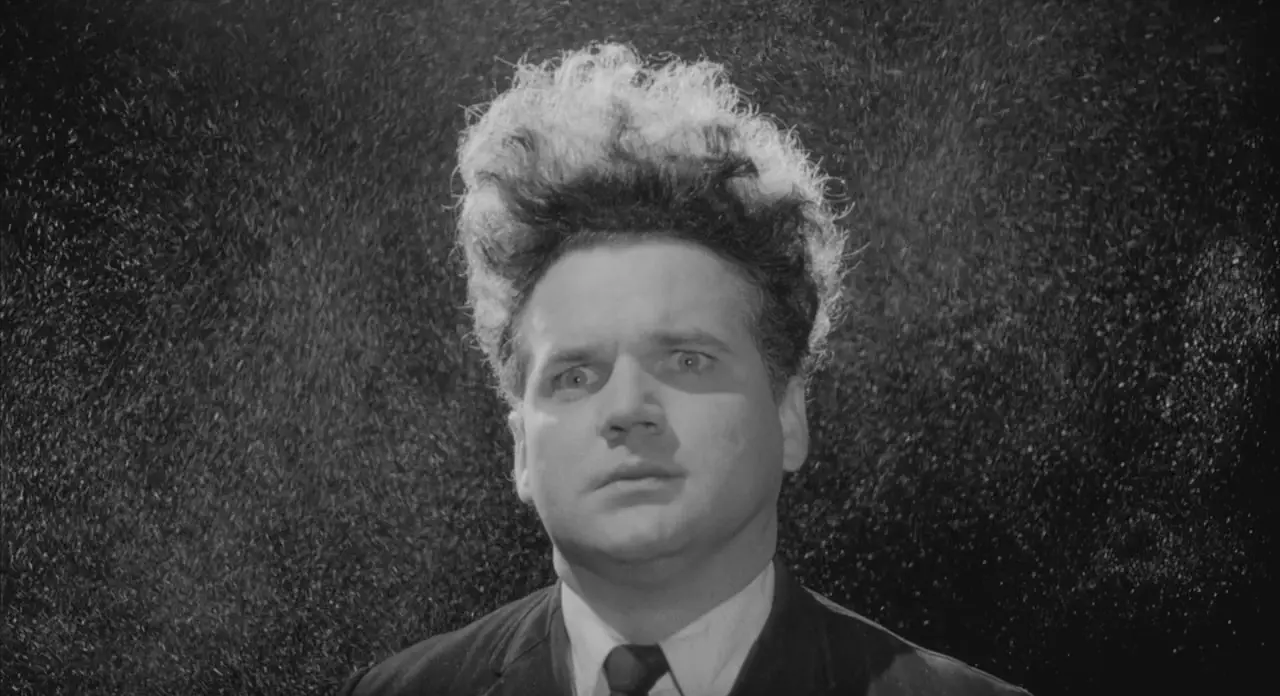
We are guided through the hole now in the rock, and see Planet Man as self, hard at work, yet seemingly in a joyous revelry amongst the creative sparks of his domain. Henry’s ego has succeeded in conscious effort by tackling an aspect of his personality that hindered his life.
Henry’s inner world begins to rejoice wholeheartedly.
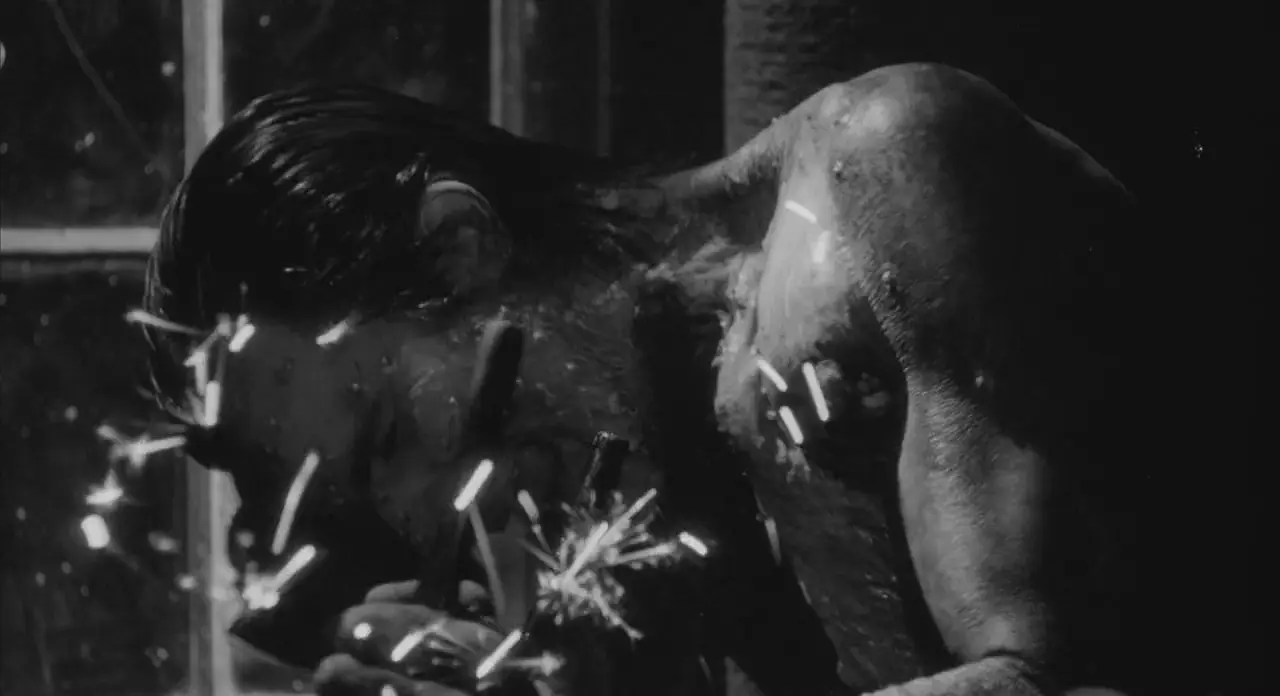
In the final scene in near white-out, we witness heaven. A state that was barred from him under certain conditions. Yet now, he stands right there in locale, as Radiator Lady approaches from behind; pure in joy and warmth. Henry, calm and receptive and comforted by her embrace. We witness a change in demeanour; maturity, he is born anew.
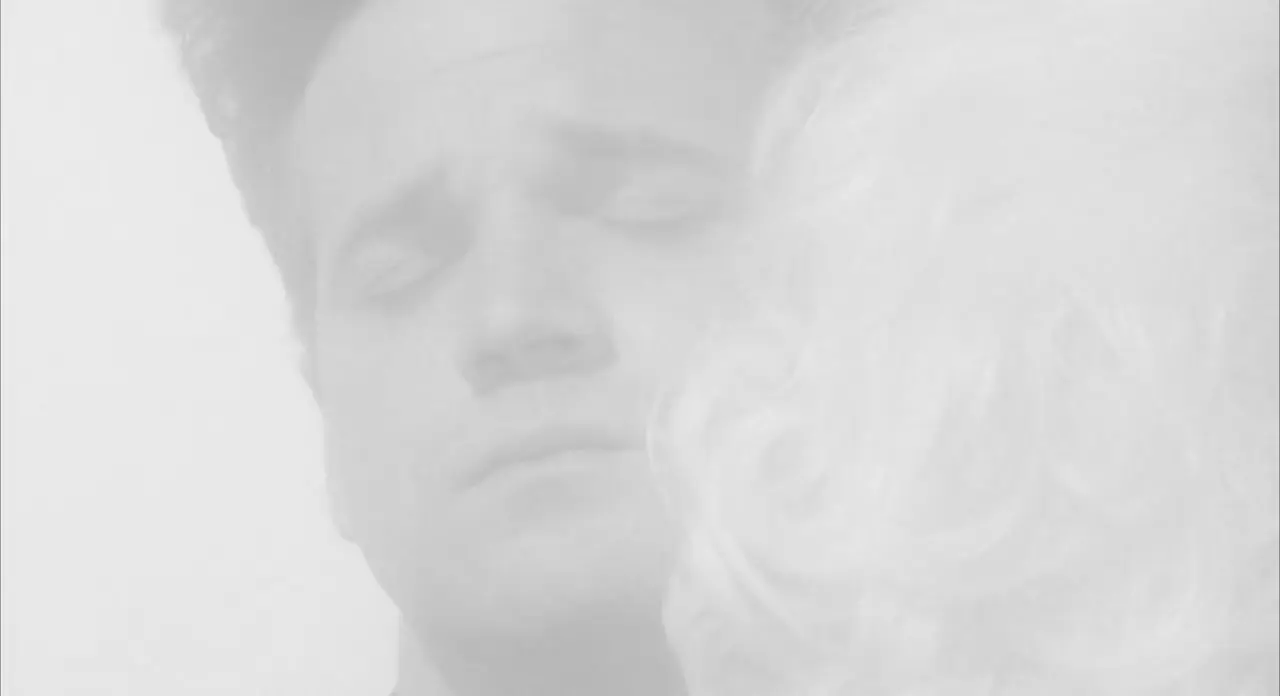
With conscious action and the ability to sacrifice what felt sacred, but was ultimately, corrupt. Henry could then access a part of himself that was seeking relationship for wholeness, the feminine within; the anima, his holy marriage.
“An encounter with the unconscious brings first darkness, disorientation and distress; but if one persists in scrutinizing the experience, its consequence is to enlarge the personality and bring one closer to wholeness” (Edward Edinger, The Mysterium Lectures, p. 210)
Final thoughts
In summary, the reluctant birth of the monstrous, by proxy, was a clear and necessary agent of transformation. This aspect within Henry's being is shown to manifest physically to draw attention to an area of development, without which his life would stagnate. It is only through the unthinkable, violent act that there was a purposeful, conscious confrontation; only made possible by a rigorous reordering of the personality, that revealed the hidden contents in the unconscious. This facilitated the emergence of a newly adapted ego, that could then relate to his inner feminine aspect: the anima. It presents to us what it means to rip open a part of oneself and face that which is unknowingly detrimental to development - a terrible, but necessary inner-surgery.
Looking at this film from a depth psychology lens, the ending to me is as good as it gets. The inner union is achieved - the holy marriage within the self. It is extremely positive, fulfilling and rewarding.
Eraserhead is obviously the film that kick-started Lynch’s illustrious, epic and innovative career. However, to see the elements of the inner personal context embedded succinctly - makes the viewing largely more interesting and profound. Lynch's work and artistry are dotted with a pure vitality for authentic expression that feels rare, compelling, and mysterious for the time period he was active. Not only was his life and career a creative endeavour, but evidently a spiritual one; with his early initiation into a path less trodden. Lynch the shaman, through an inner sacrifice of his own, communed in the wellspring of the muses.
David Lynch’s life and works will undoubtedly continue to capture hearts and minds as a deep loss is felt through his passing beyond the veil.
In Memory, David Lynch 1946-2025.
I feel it fitting to end with a particular song by Donovan, filmed and recorded by Lynch in his studio.
P.S ... Jen Lynch on Reddit
Shortly after completing the article and in the process of editing. Jenifer Lynch, David Lynch’s daughter, who was born while filming Eraserhead, jumped on Reddit to release some intimate family photos of herself and her father.
Publicly, she has been known to comment on the film as potentially related to some anxiety about her birth.
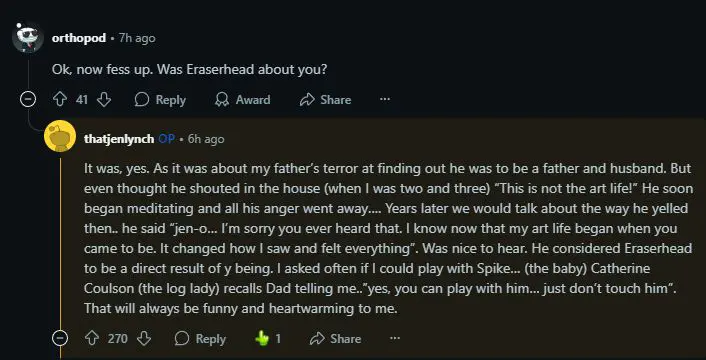
However, what’s now revealed in her reply to the question, makes it clear that her birth was not the source of turmoil to warrant such a film if it were to take on the typical meaning that has lingered in the zeitgeist, or how it has been long recognised to be.
As relayed in my essay, his sacred initiation into a creative path was emboldened by the inner work and the birth of his daughter, not a detriment. However, what was ‘sacrificed’ as Spike; may have been a version of himself that he thought needed to be free to pursue the ideal artist's life.
Indeed, spiritual.
If you enjoyed this article or have found it useful, consider sharing, commenting or even donating. Many thanks!
